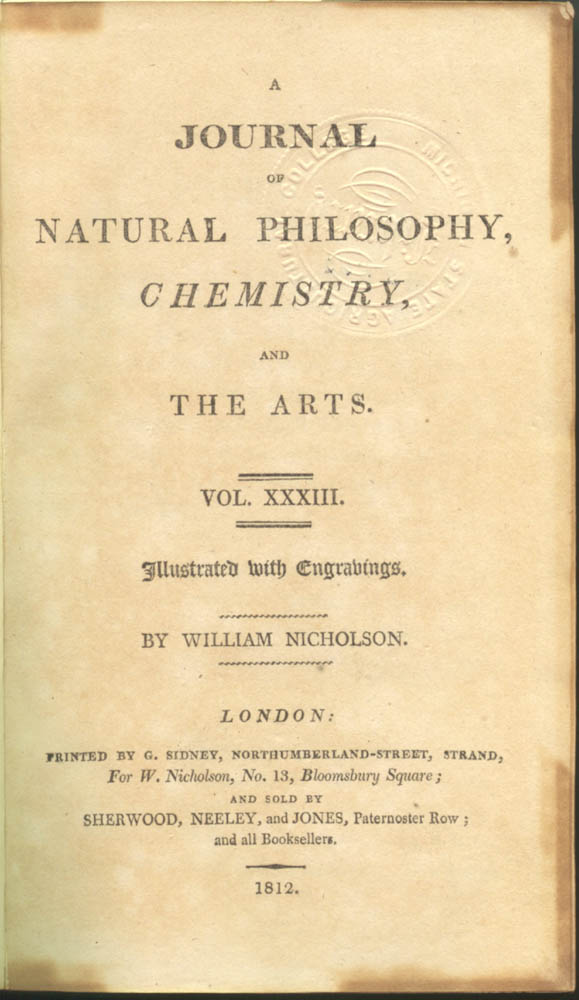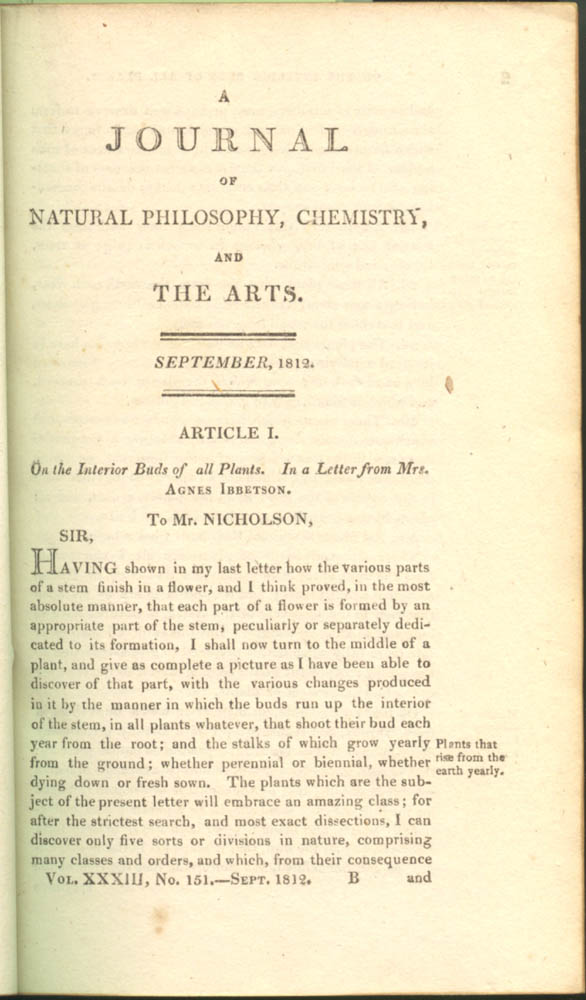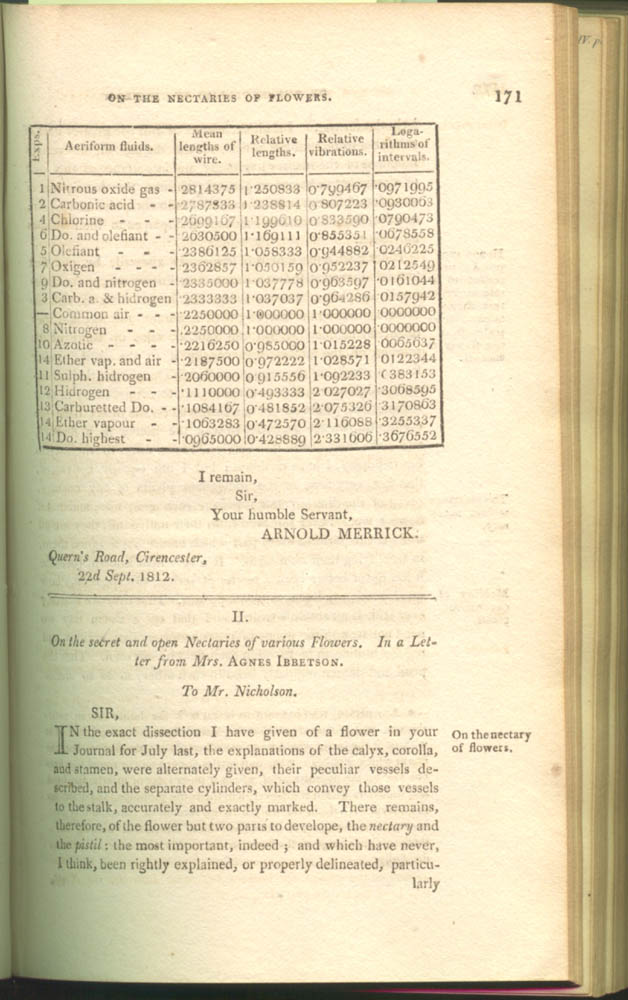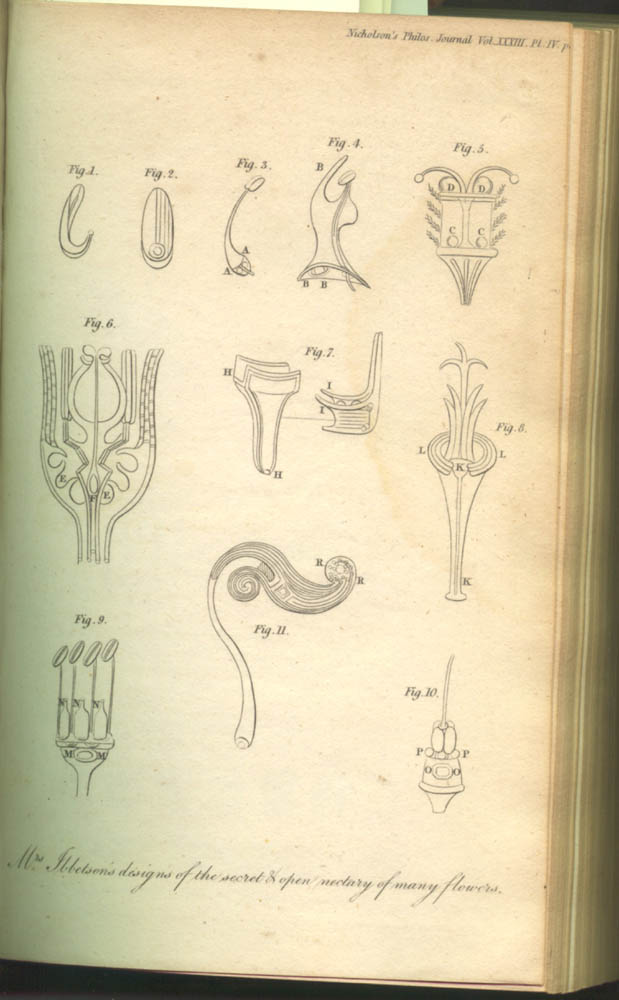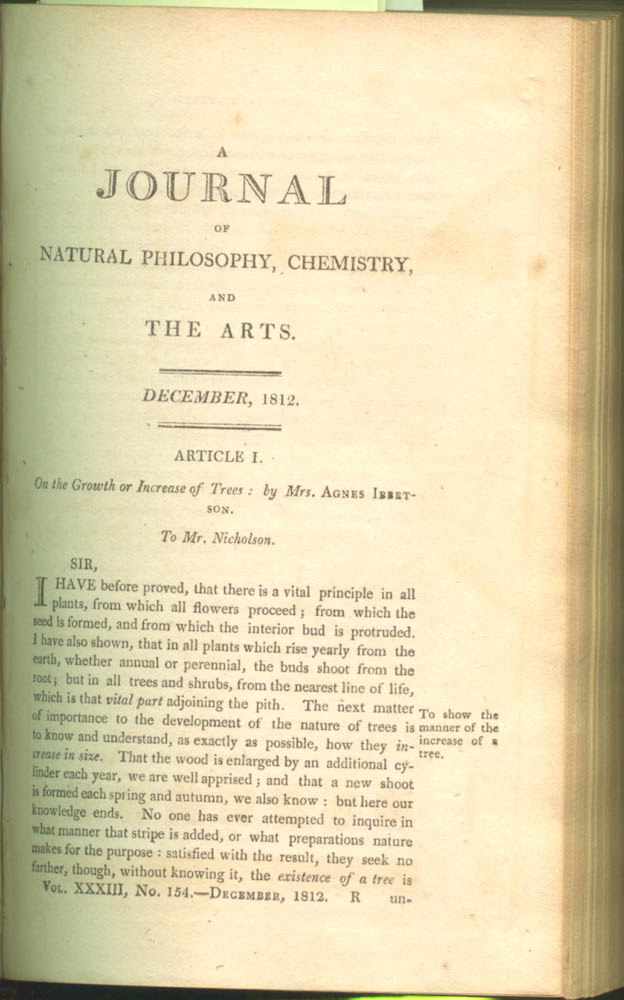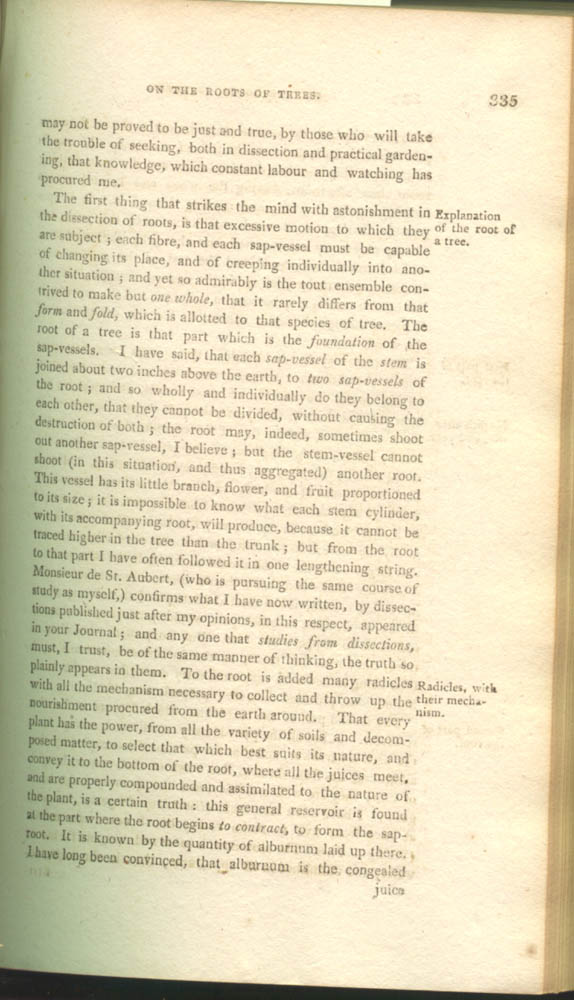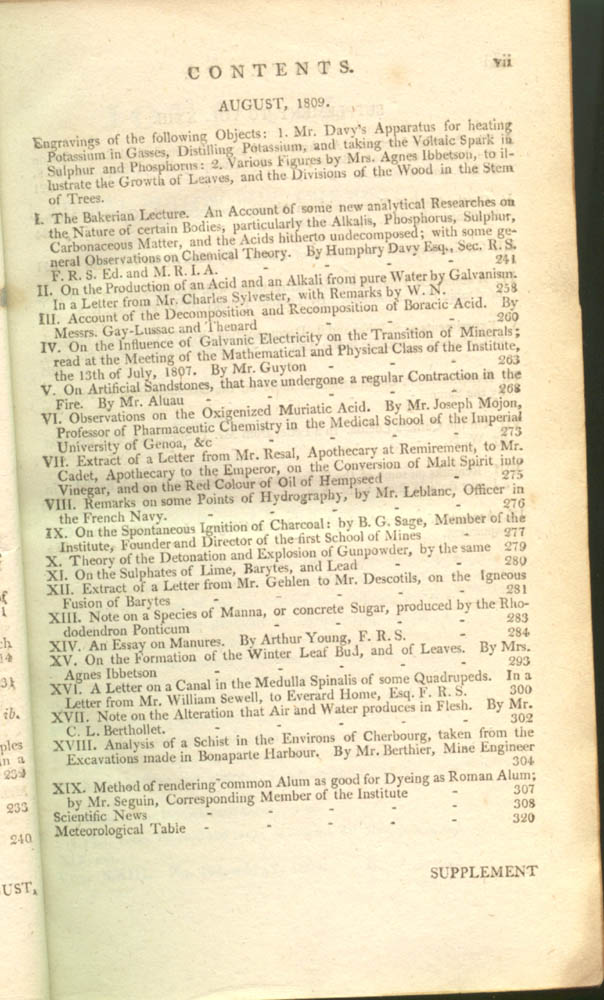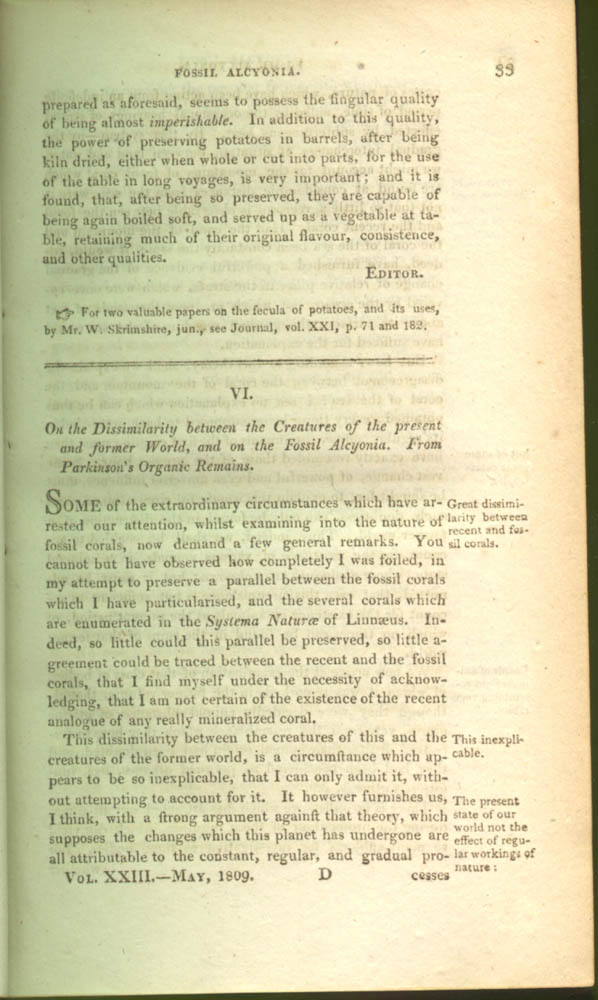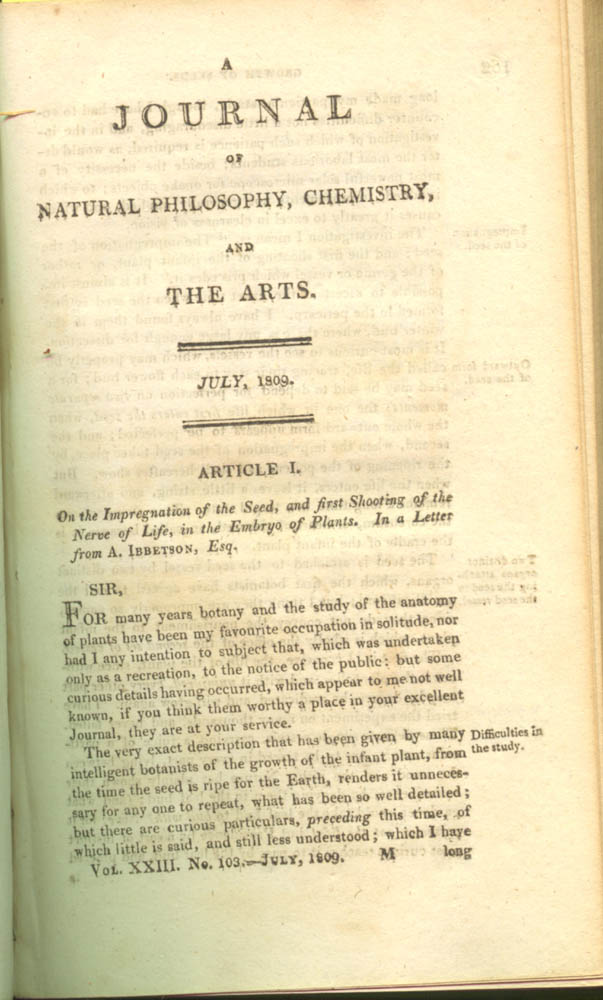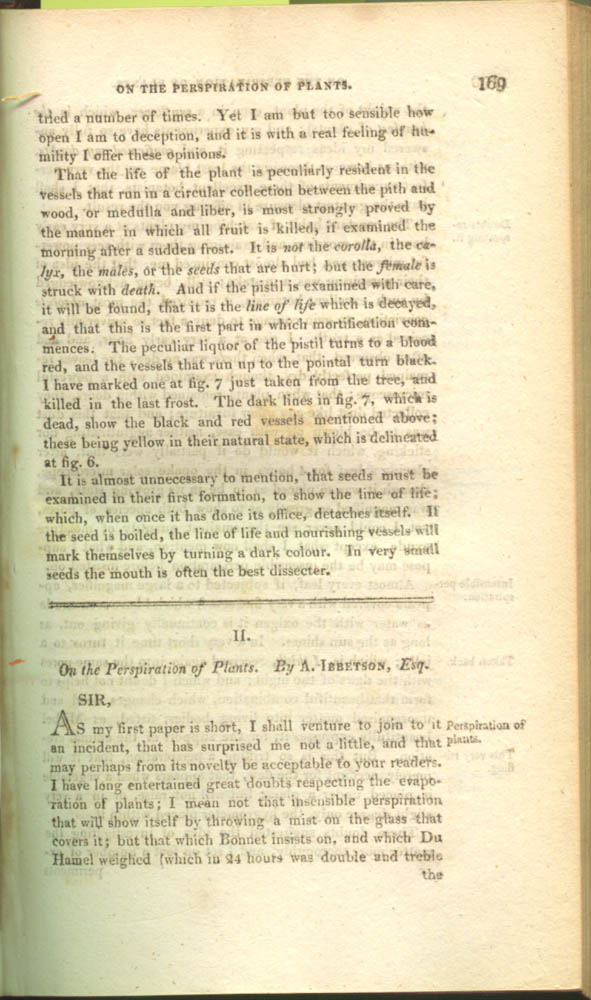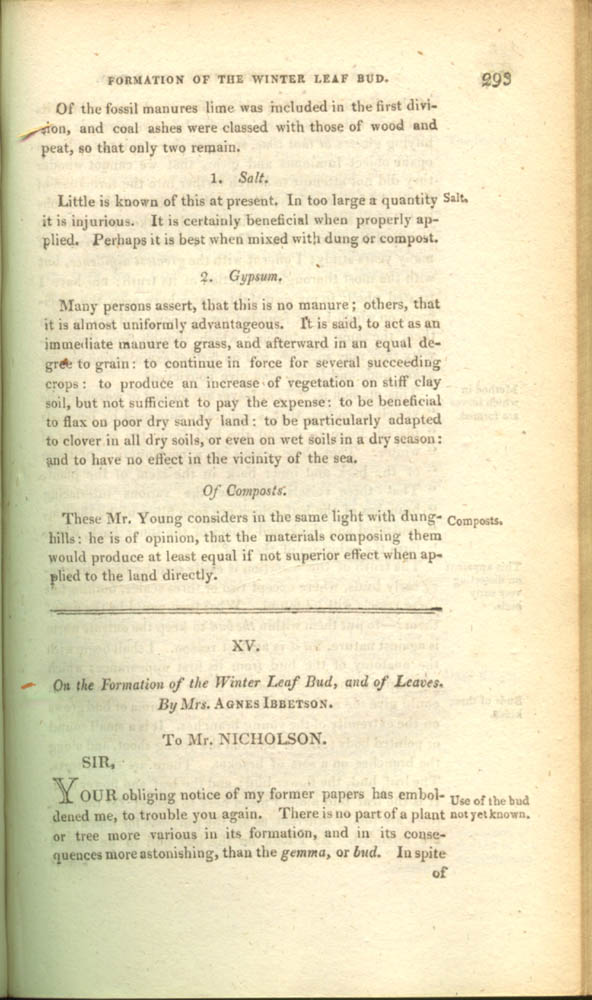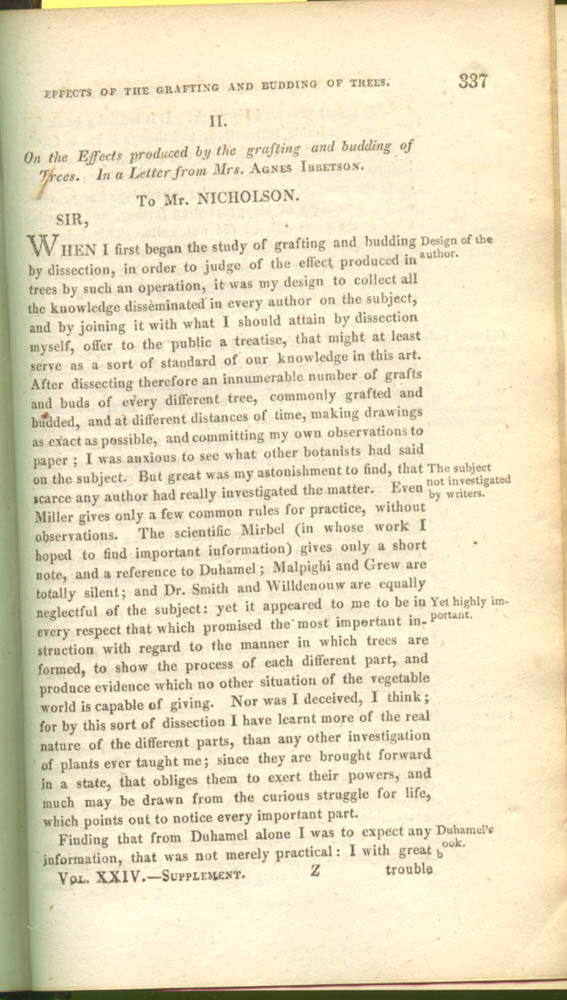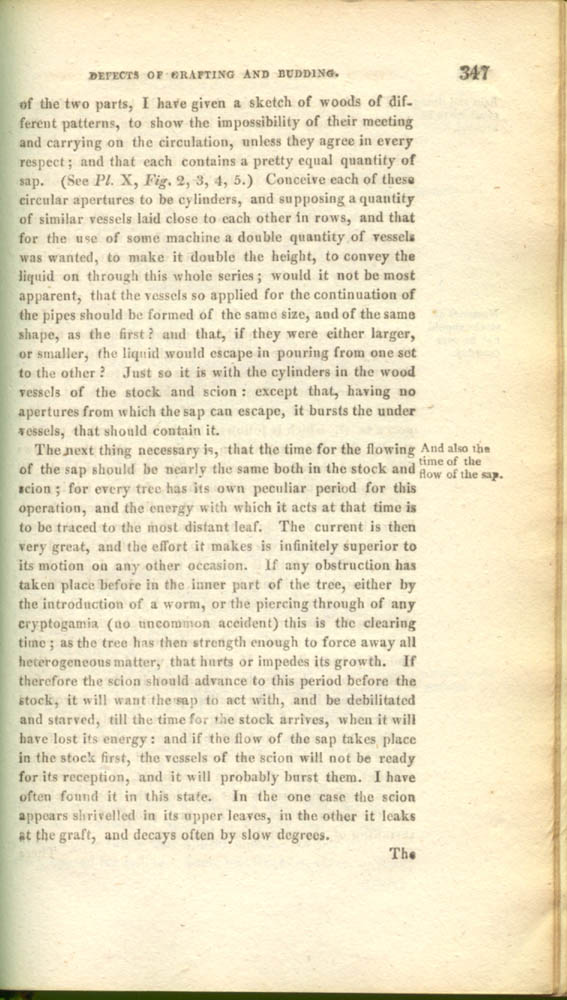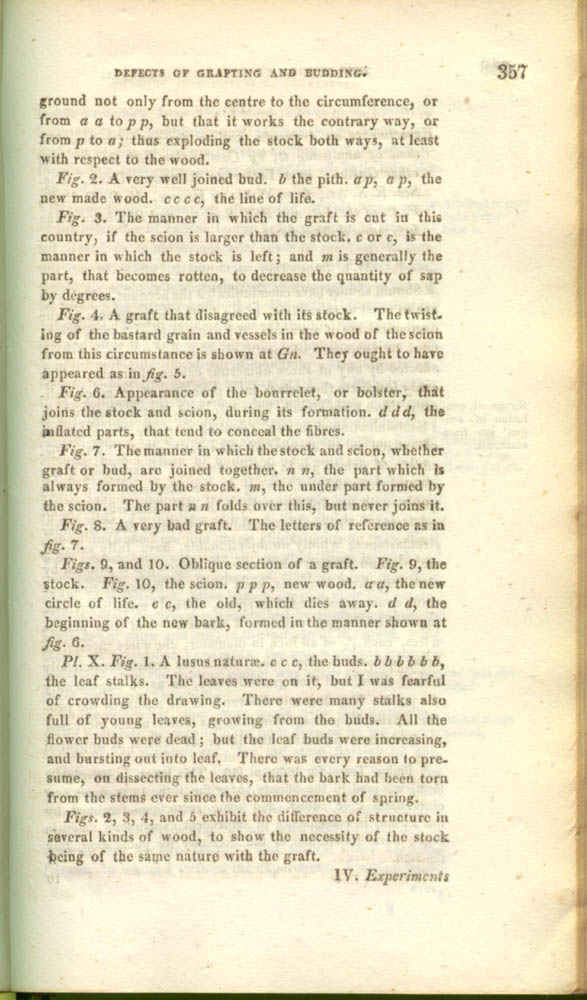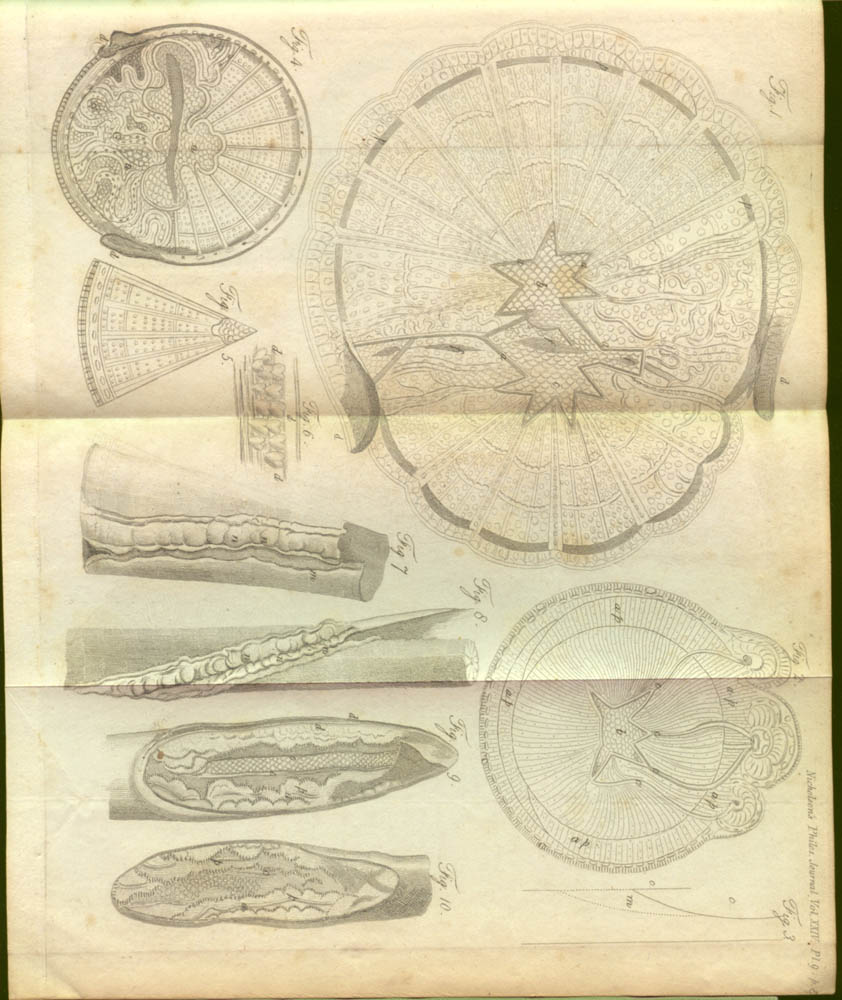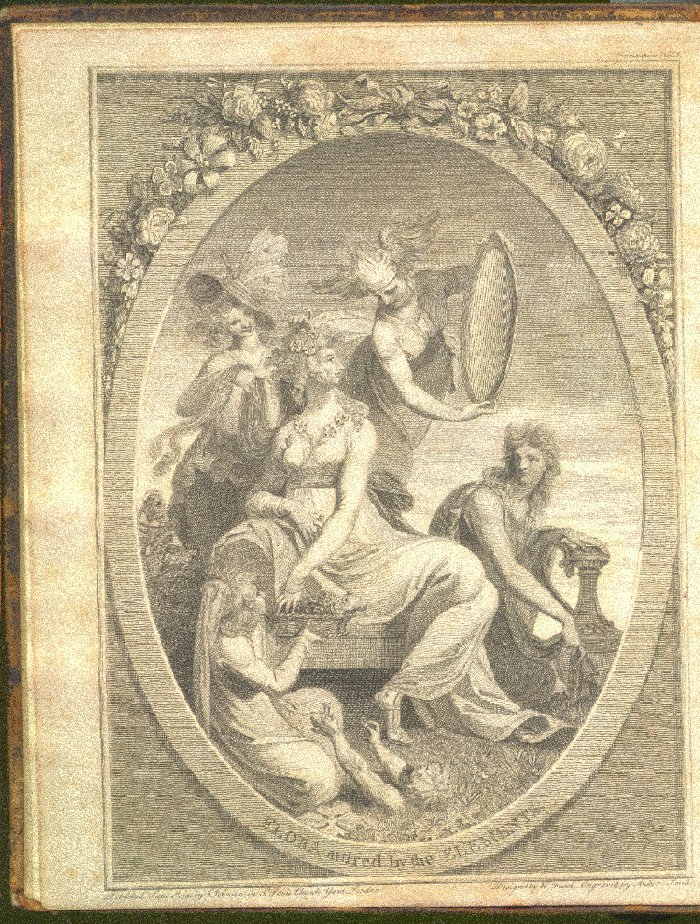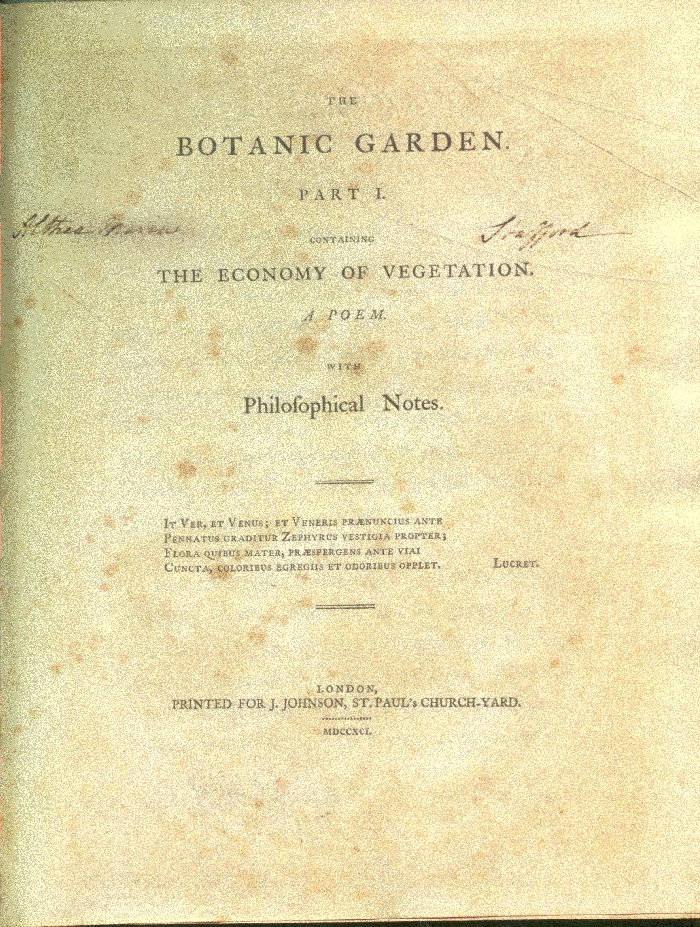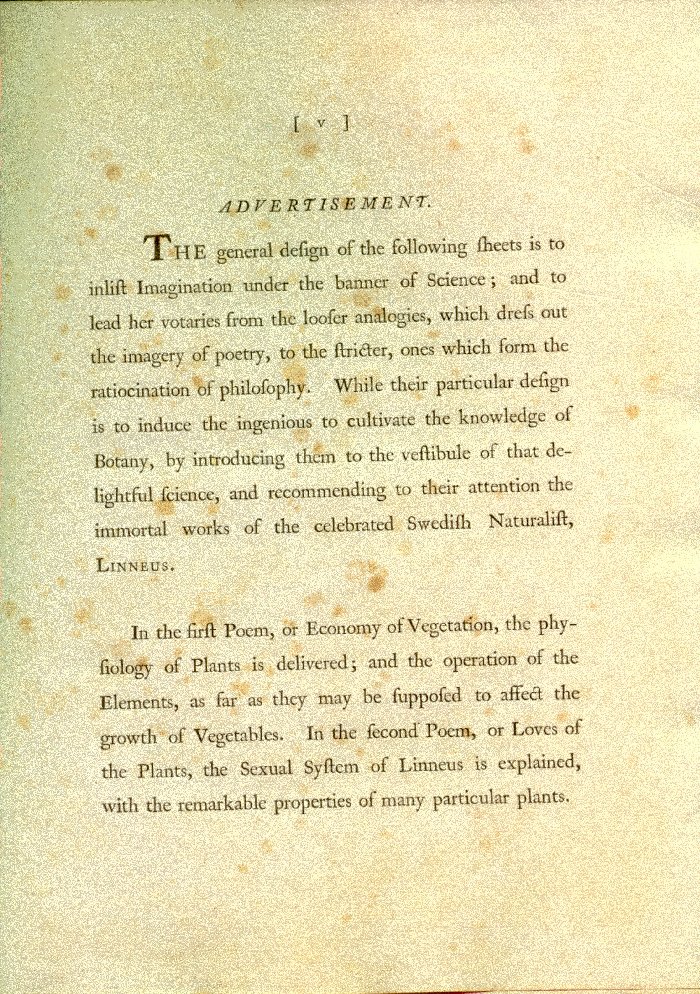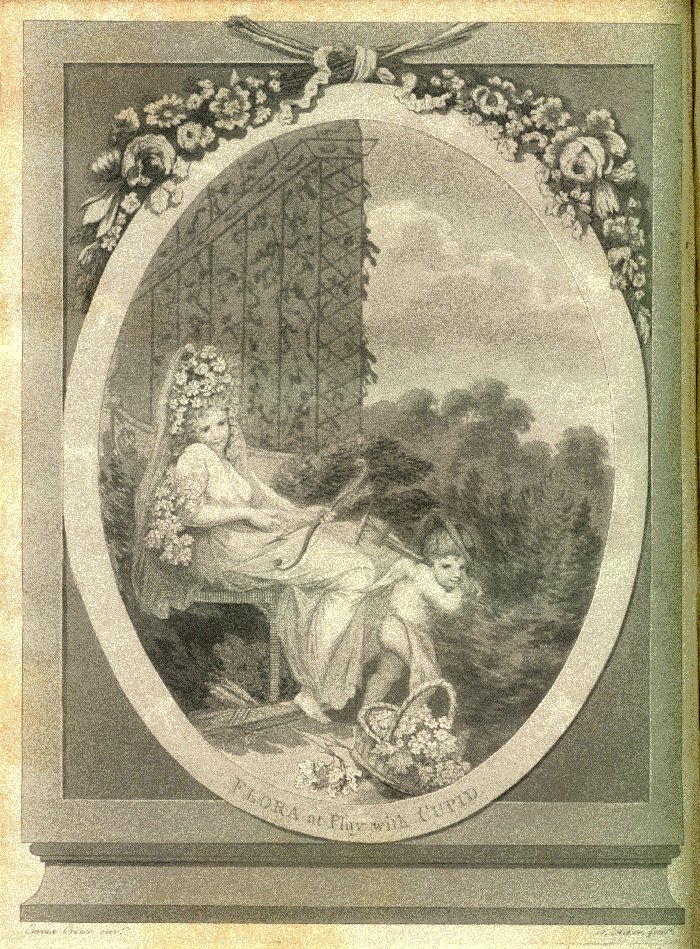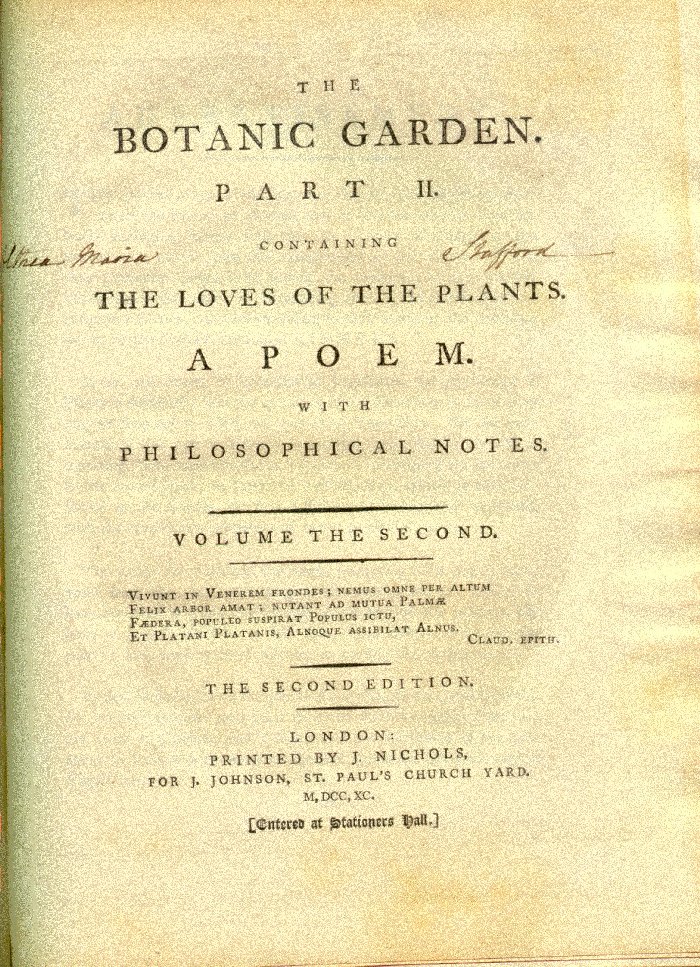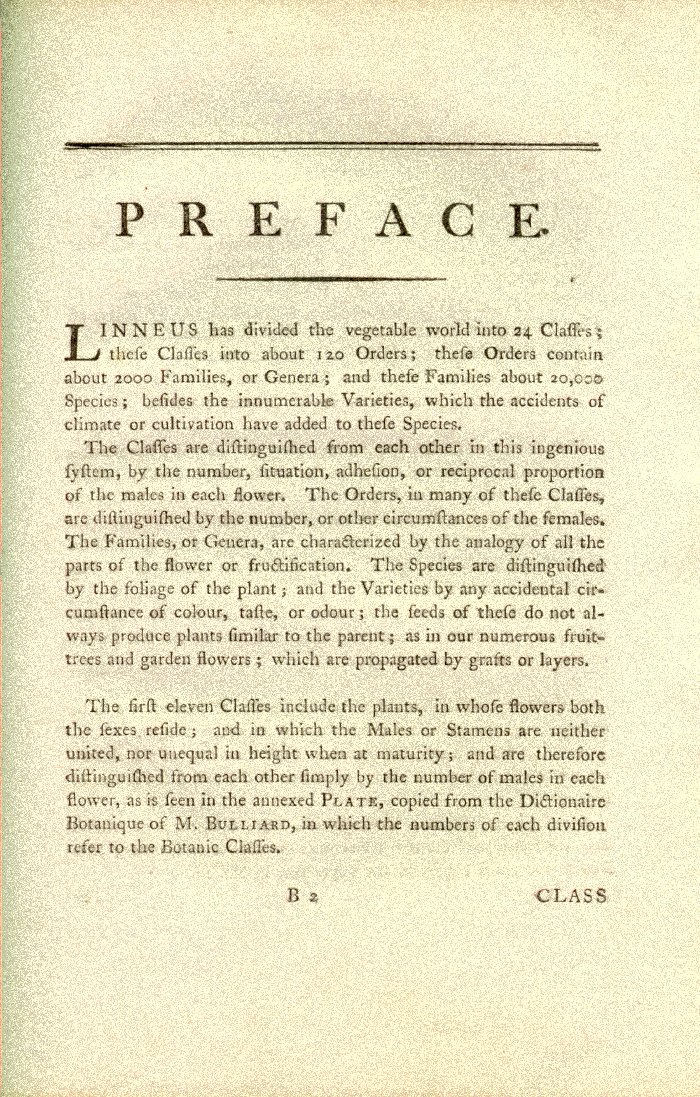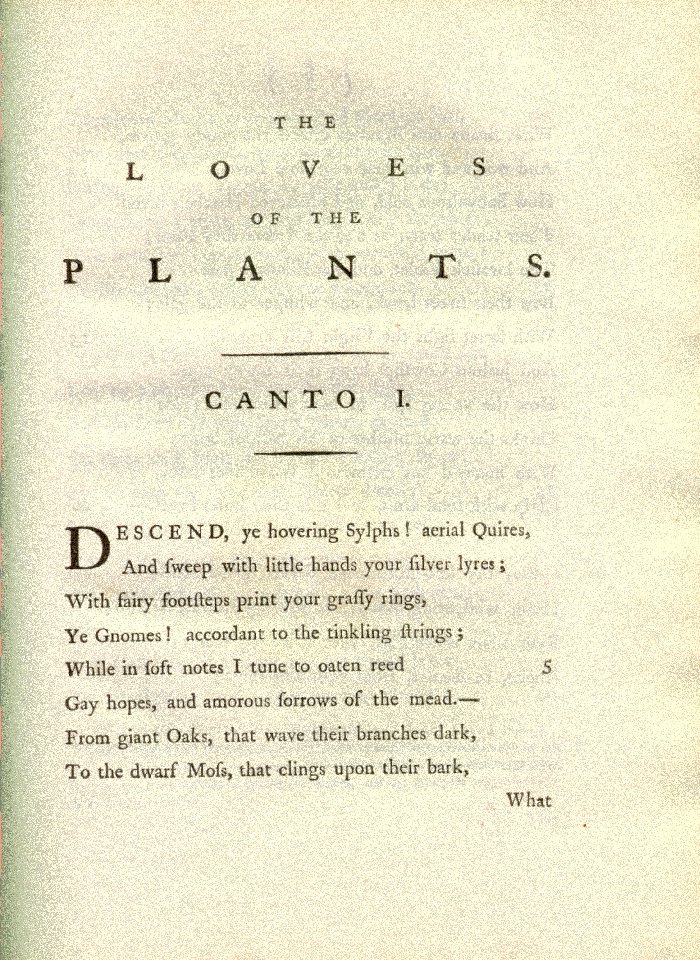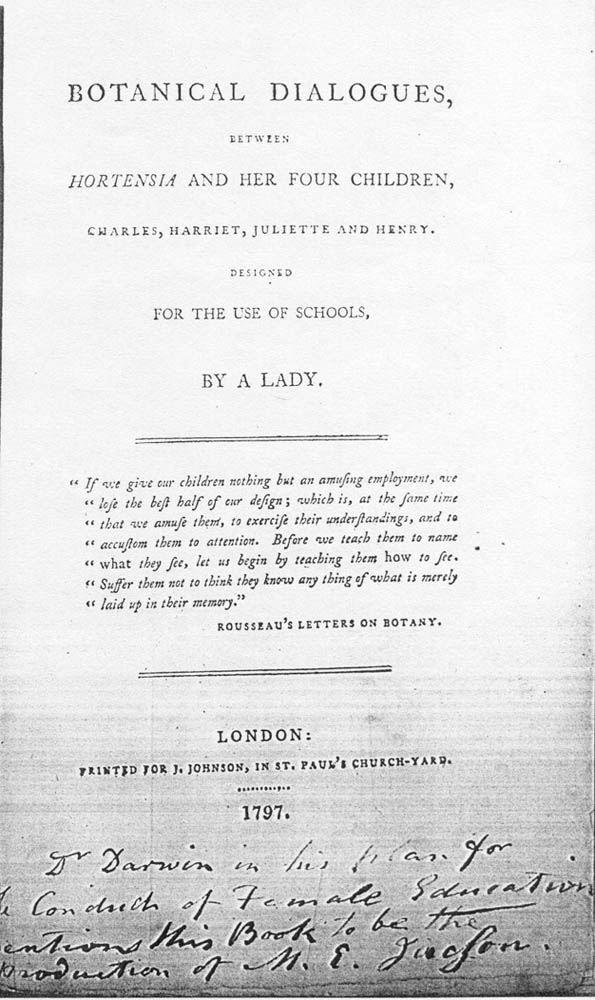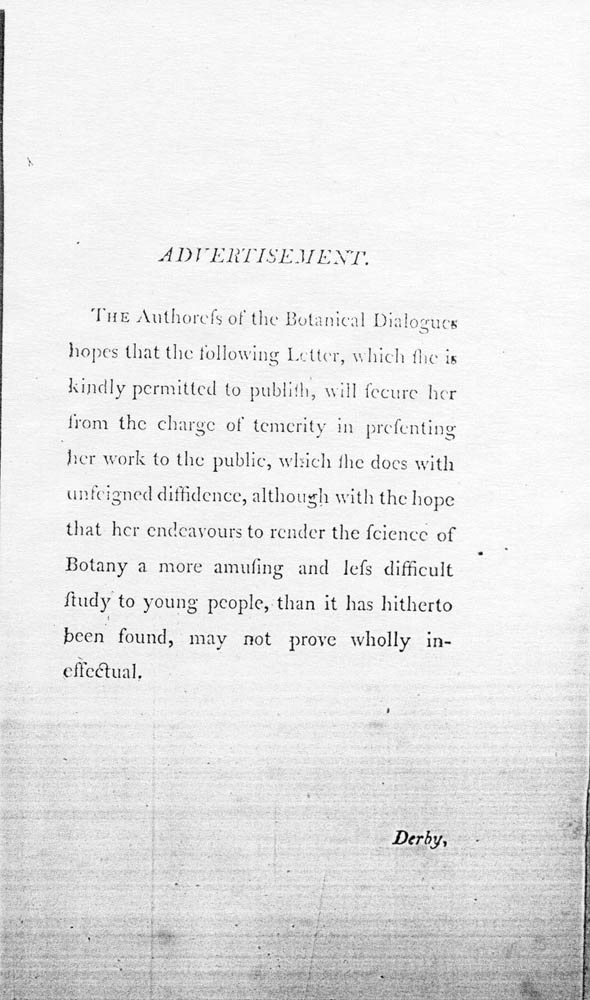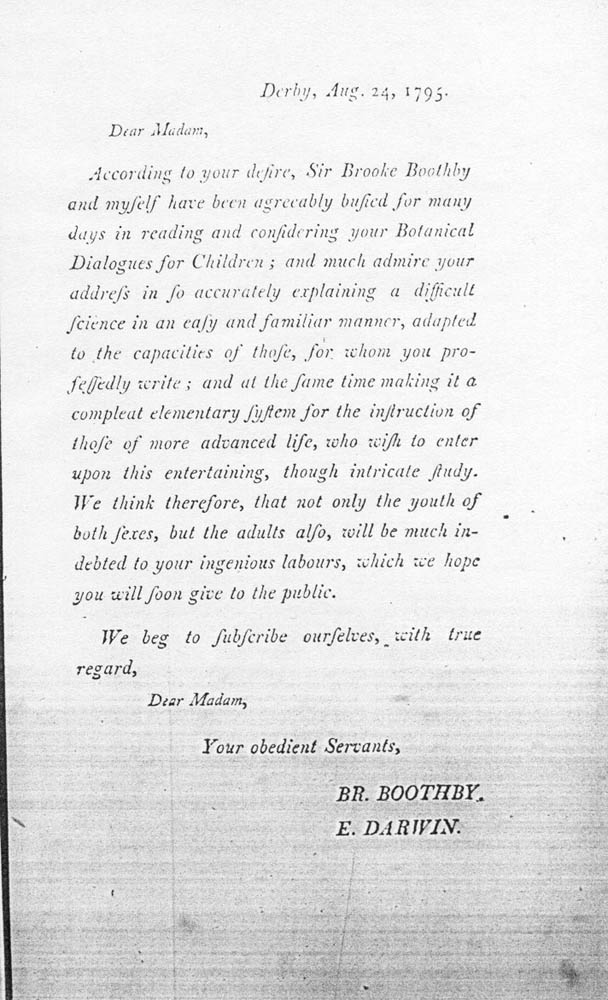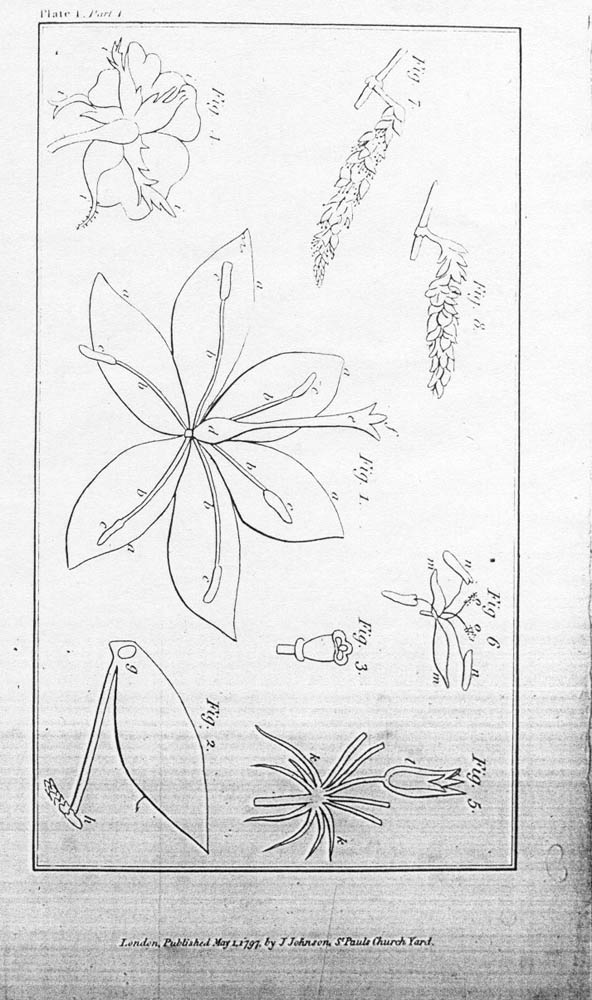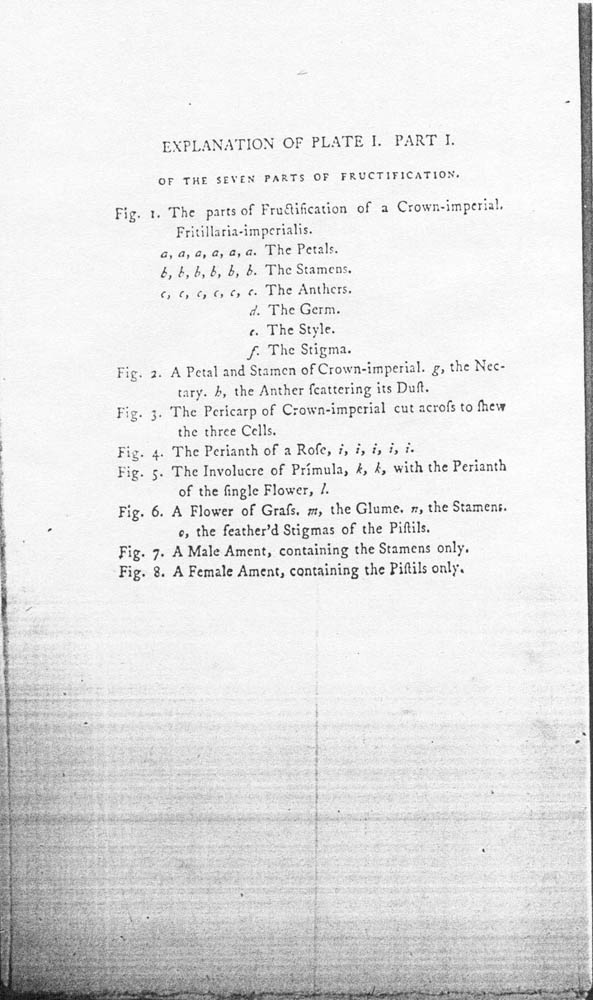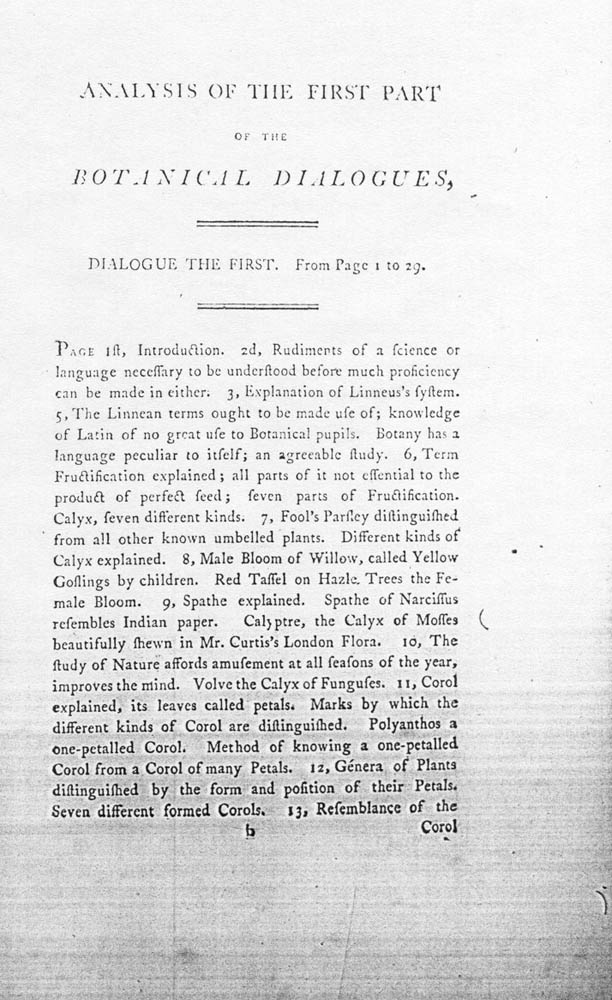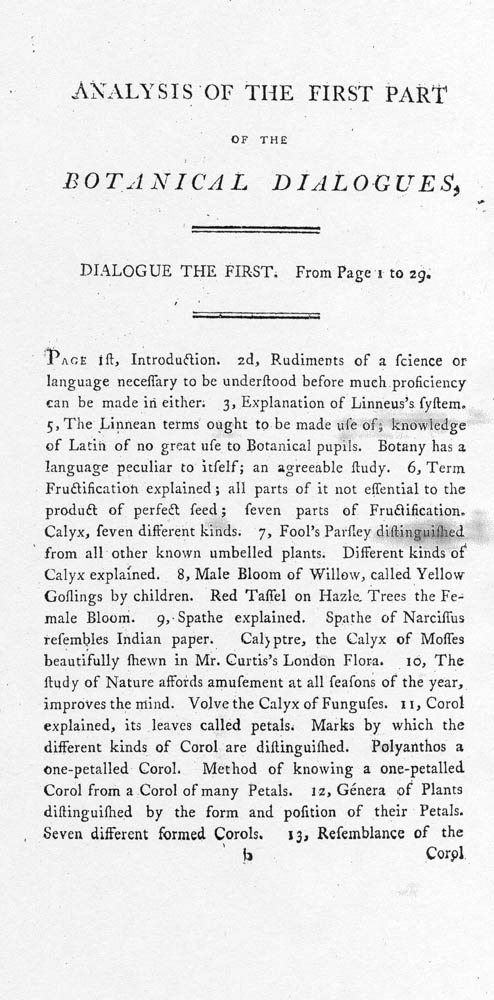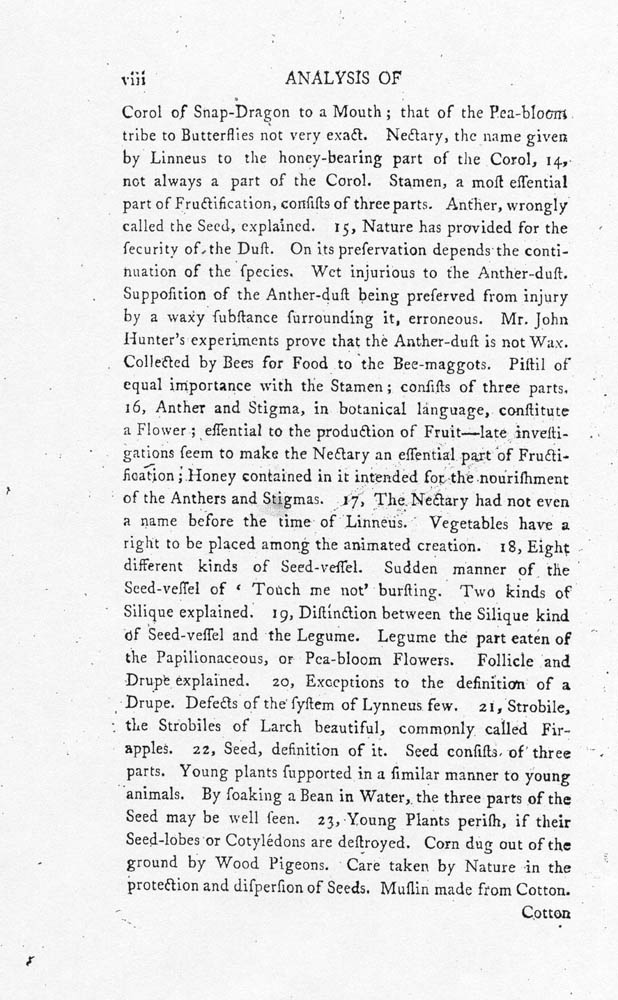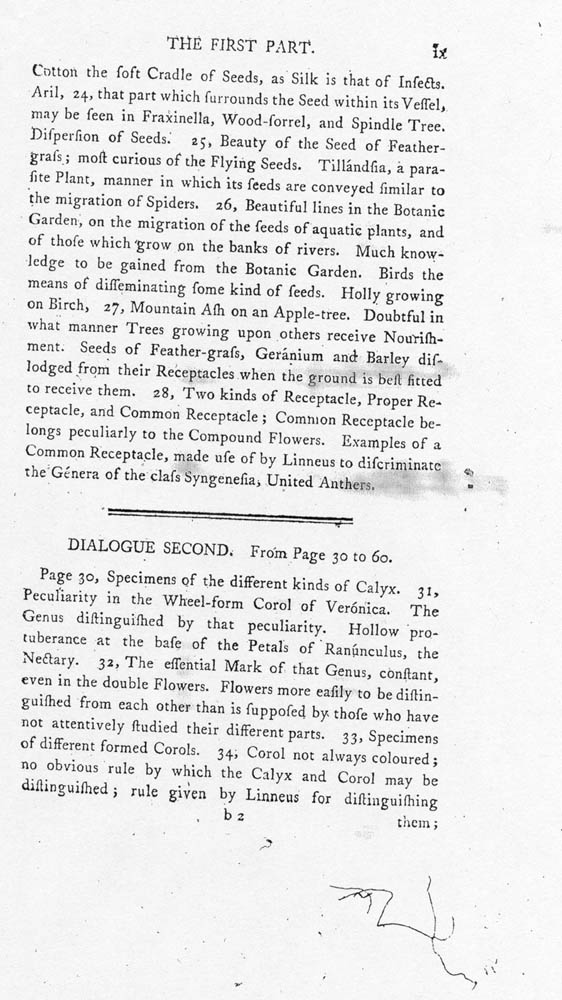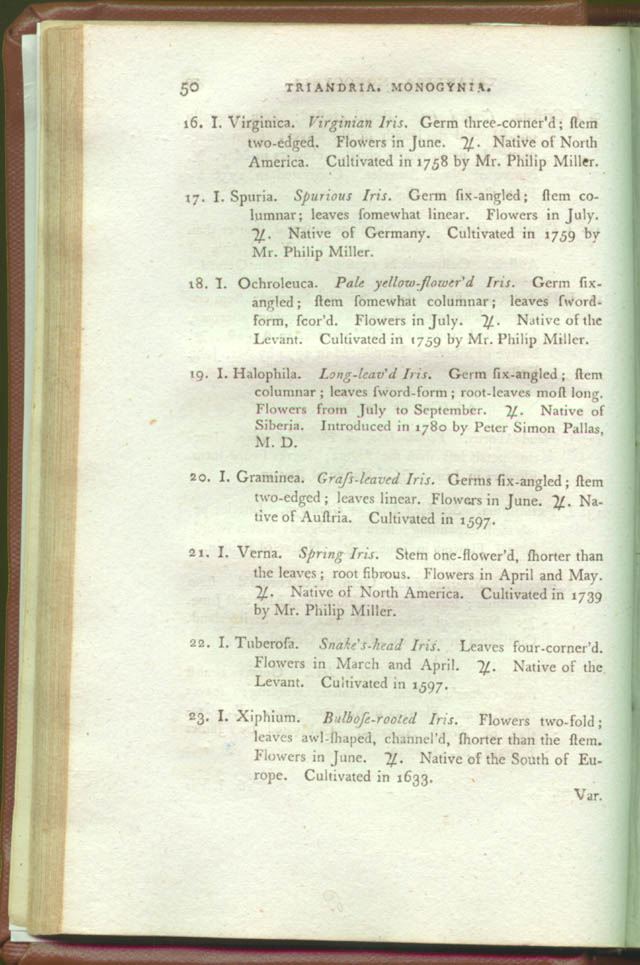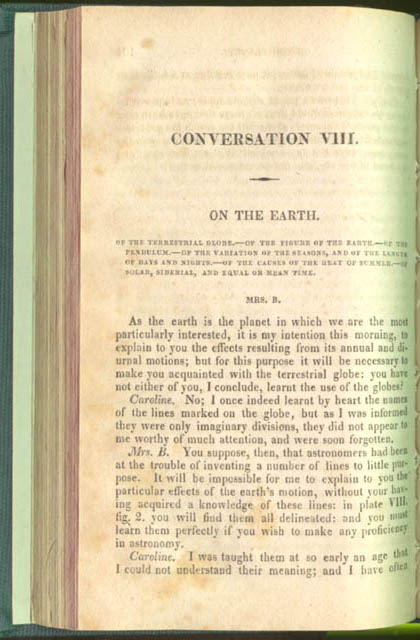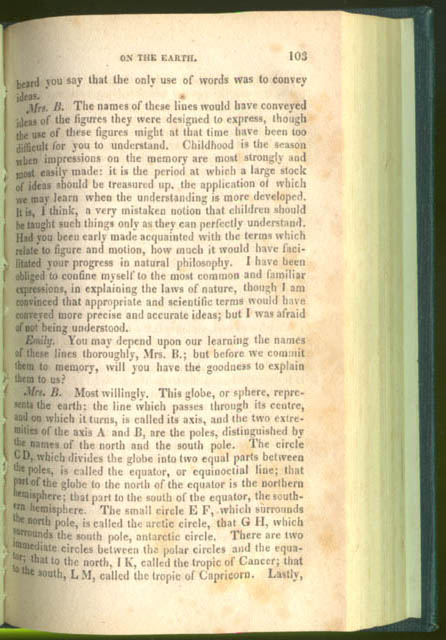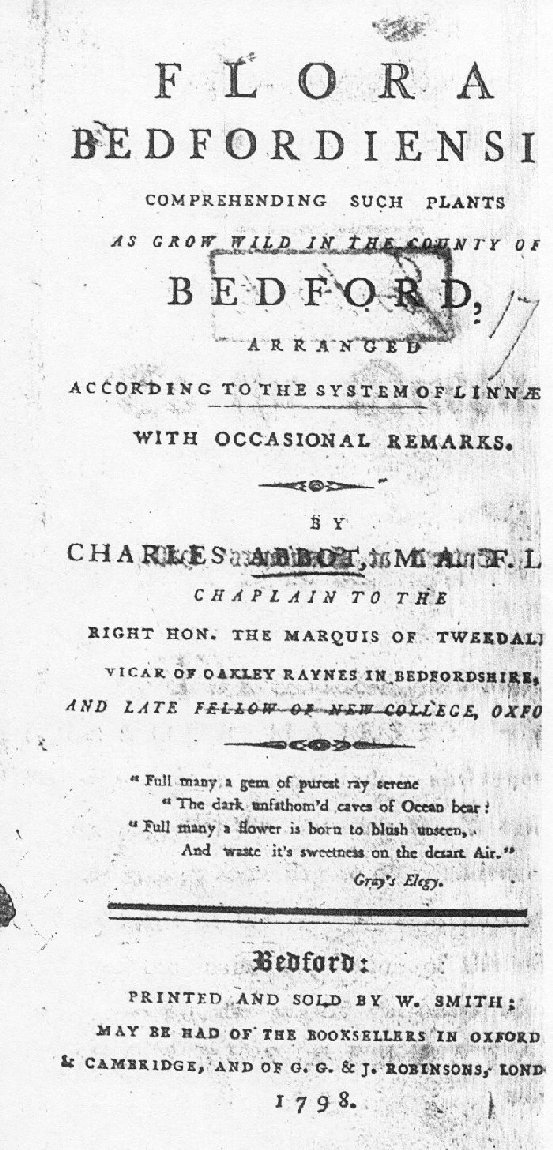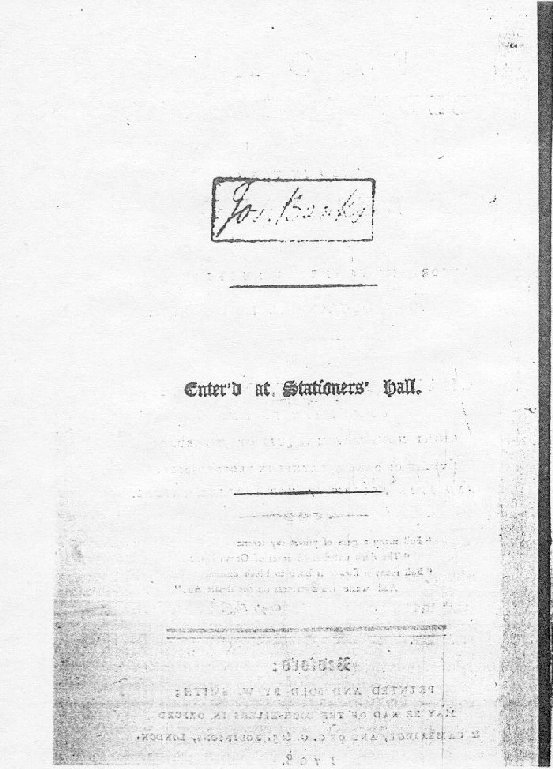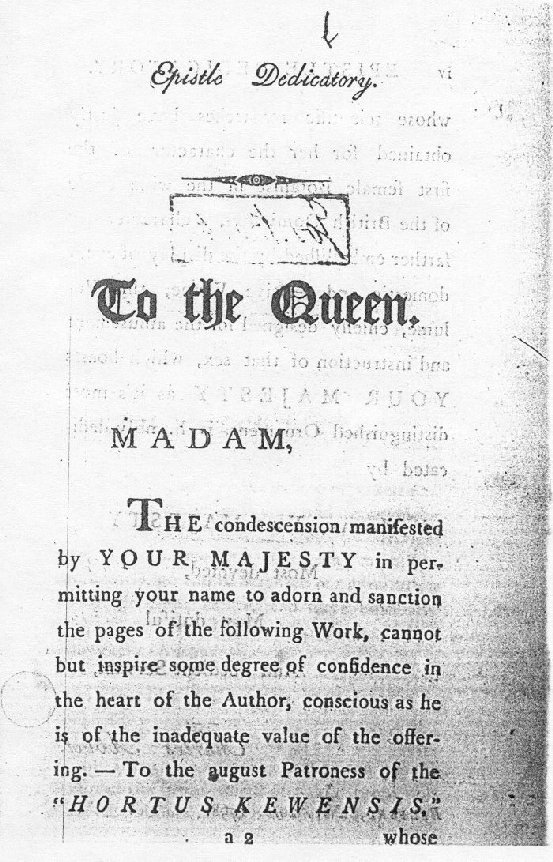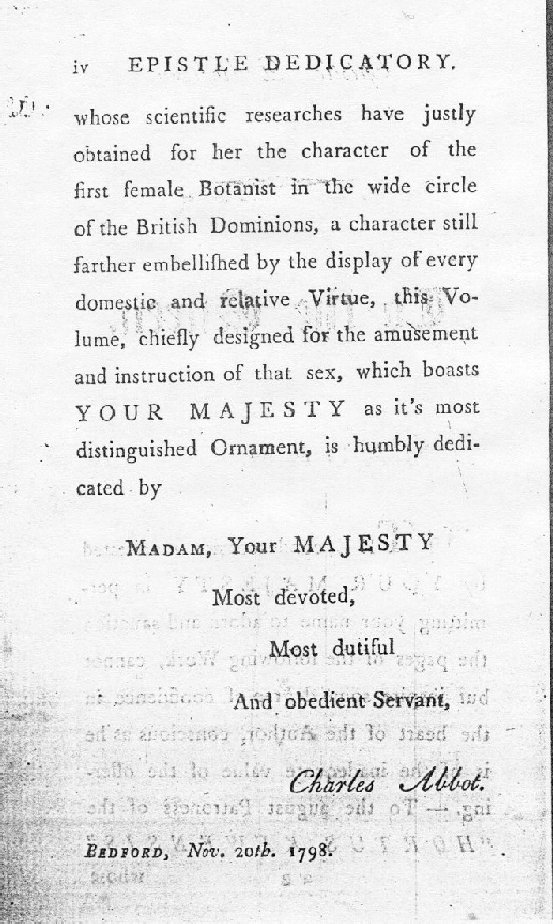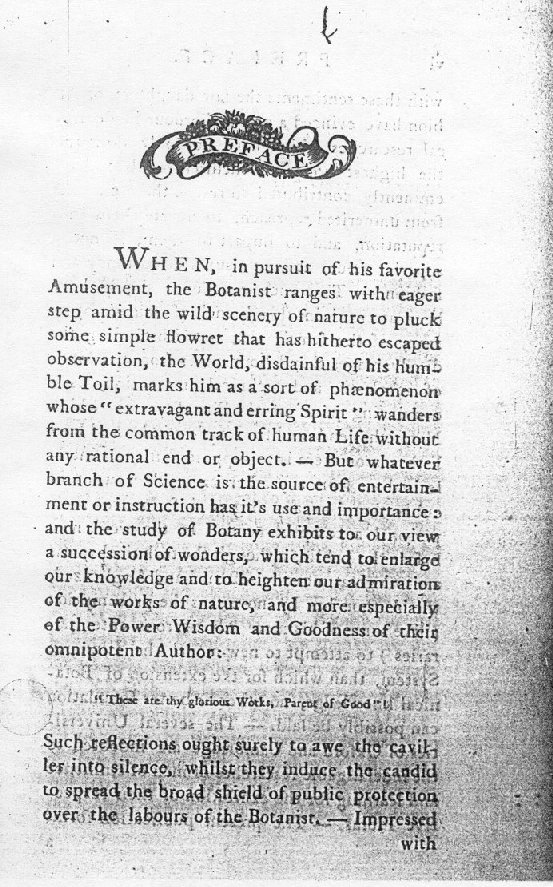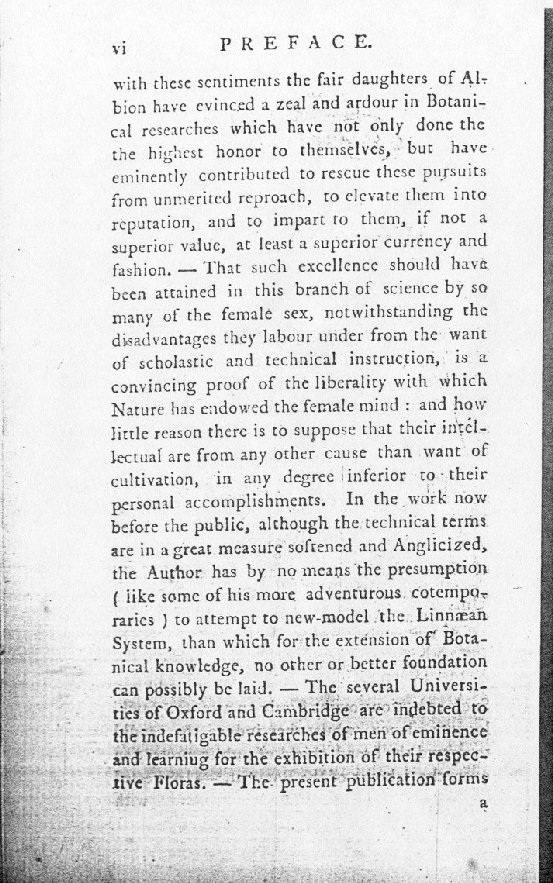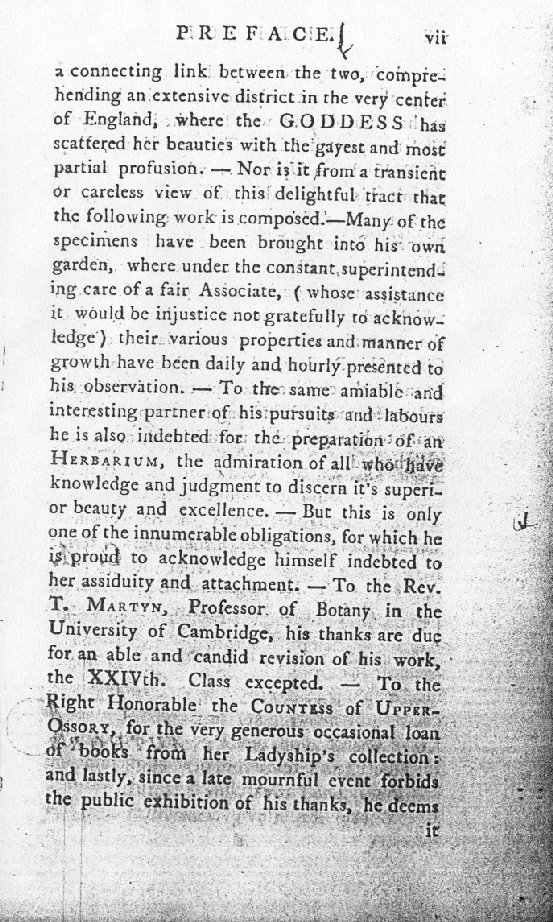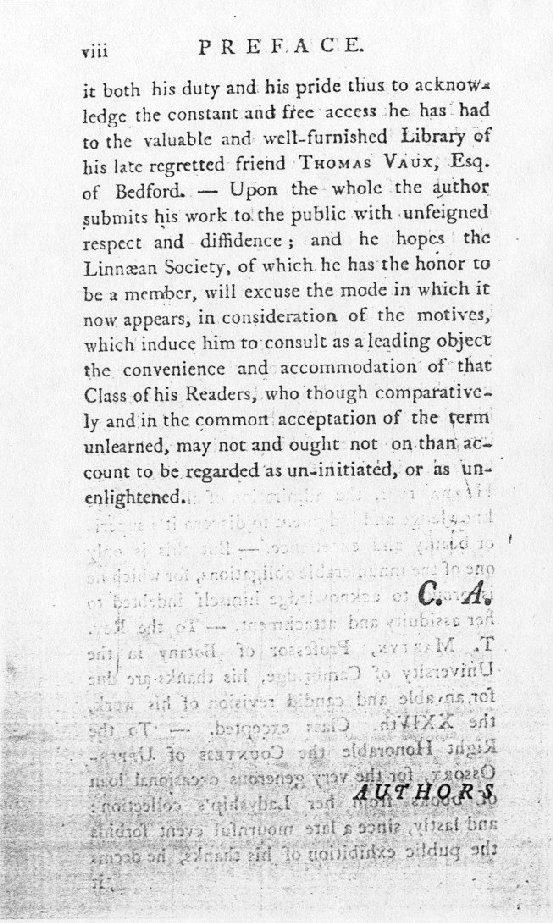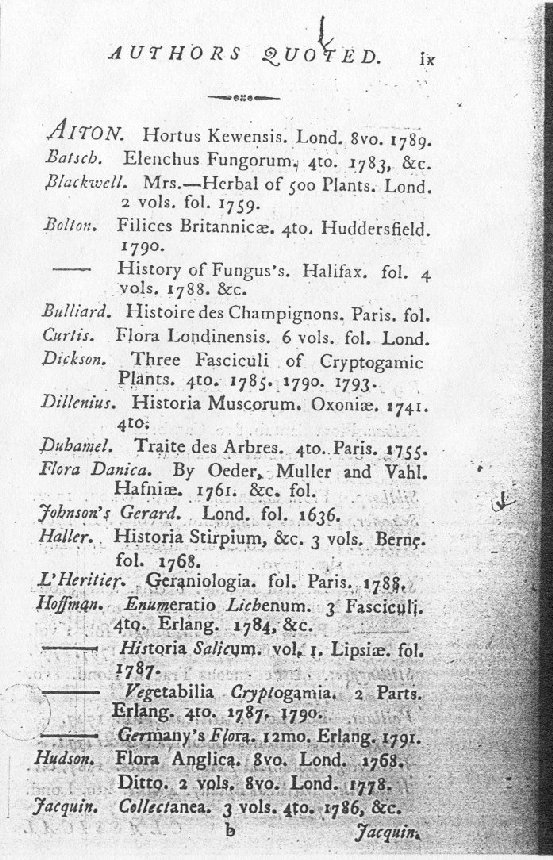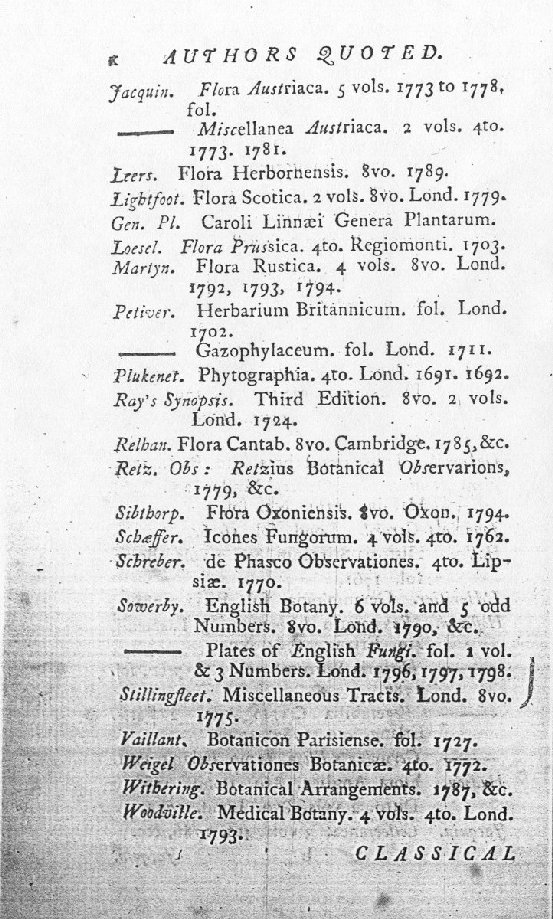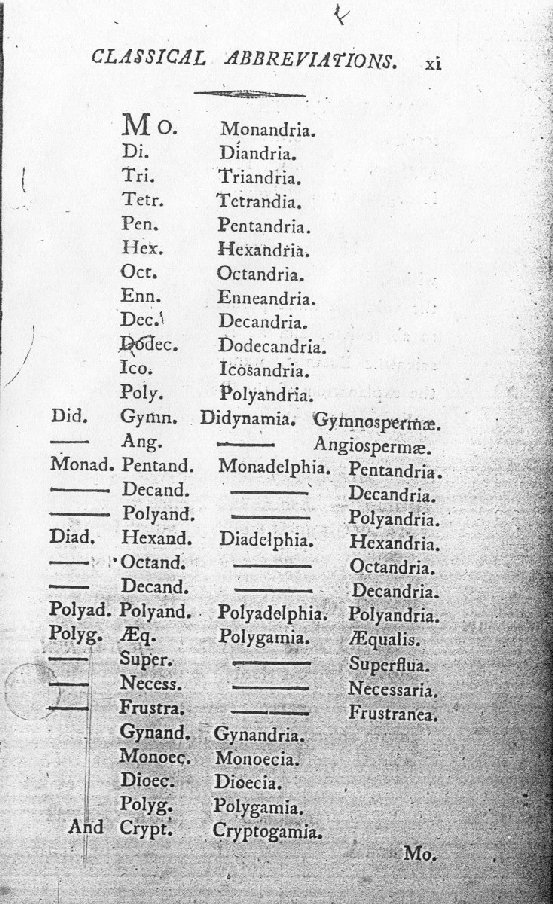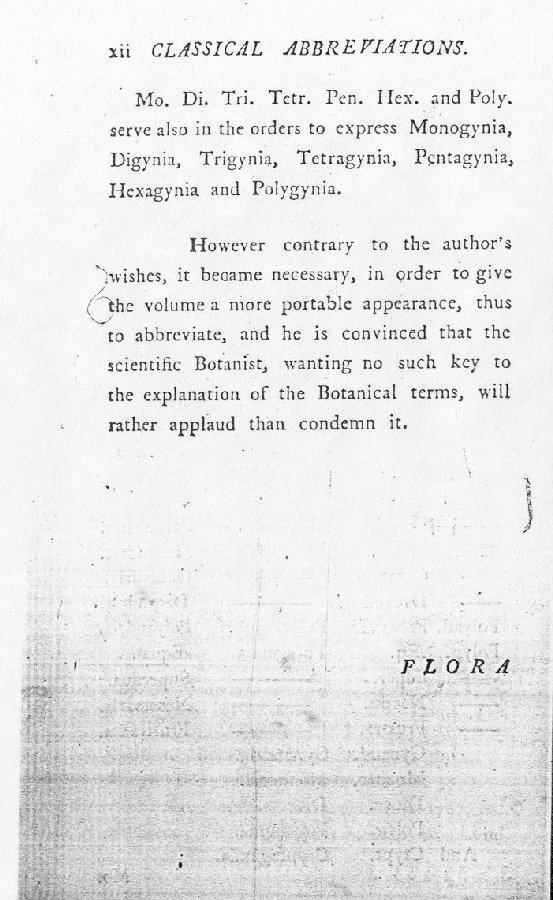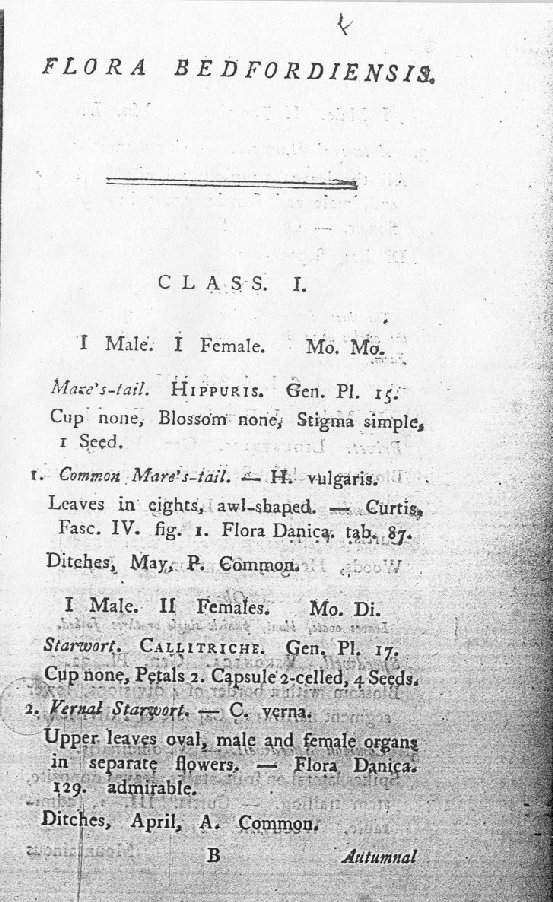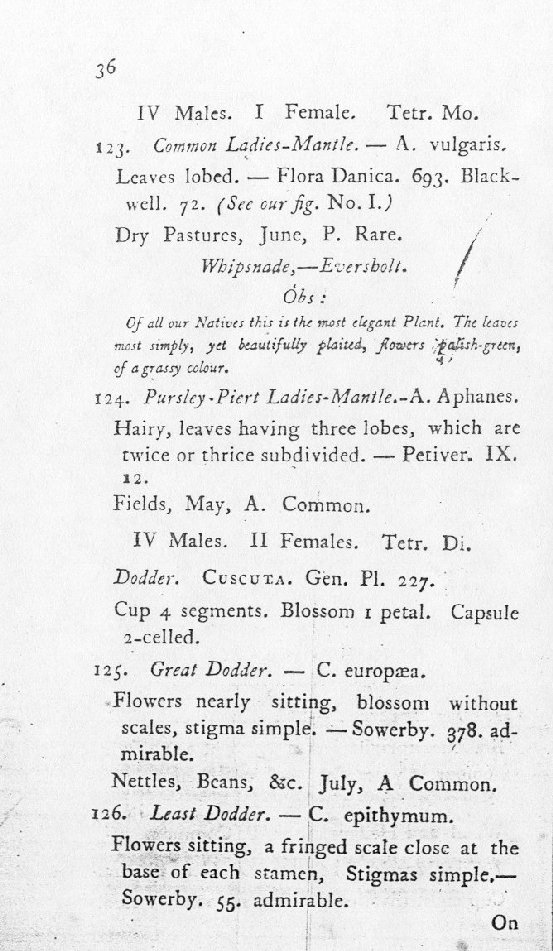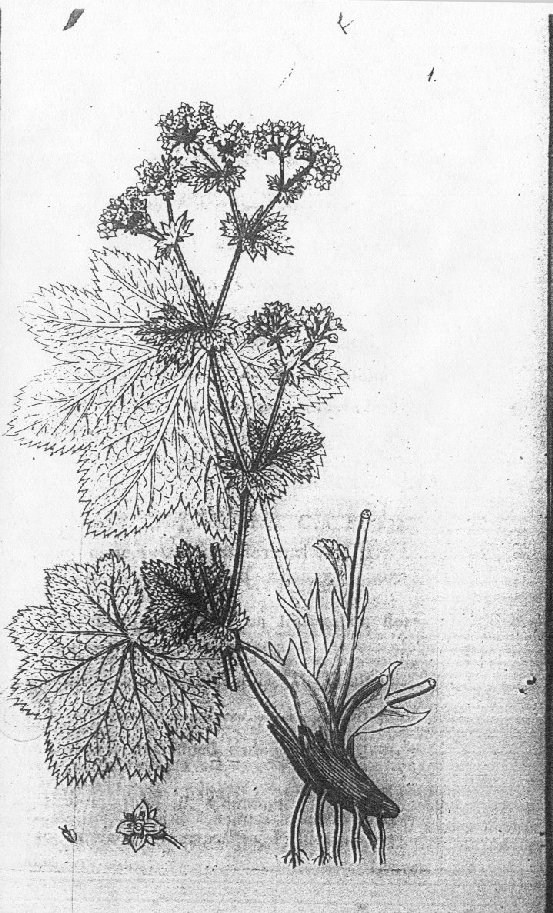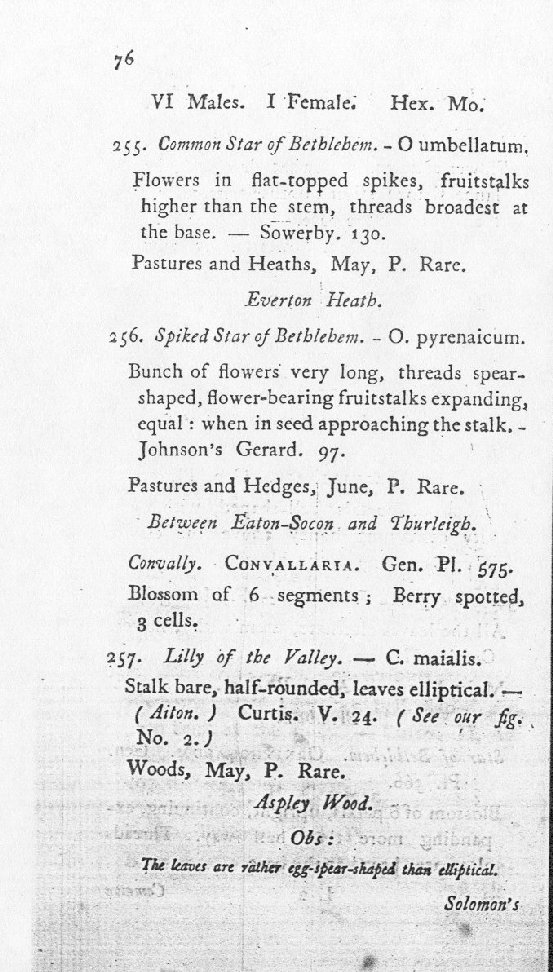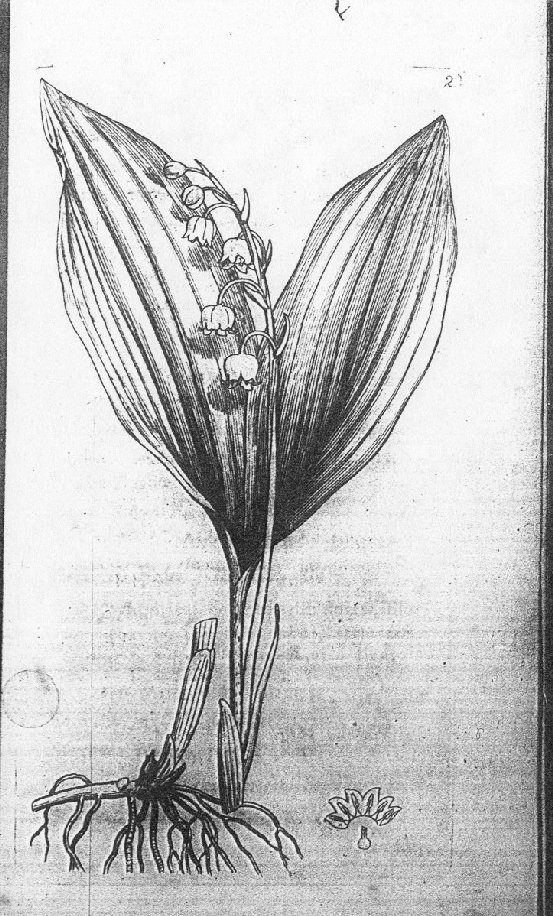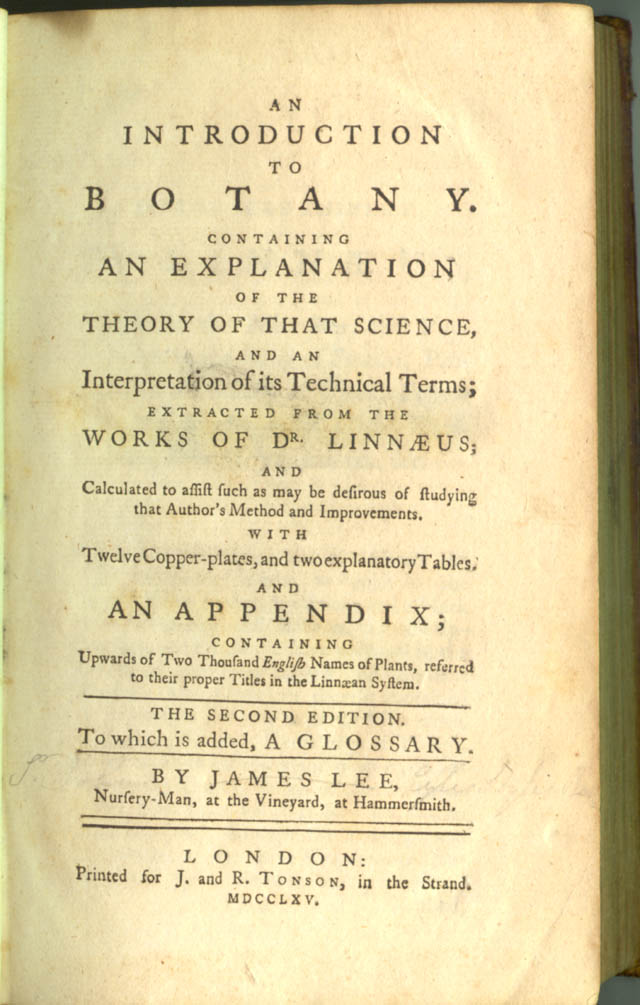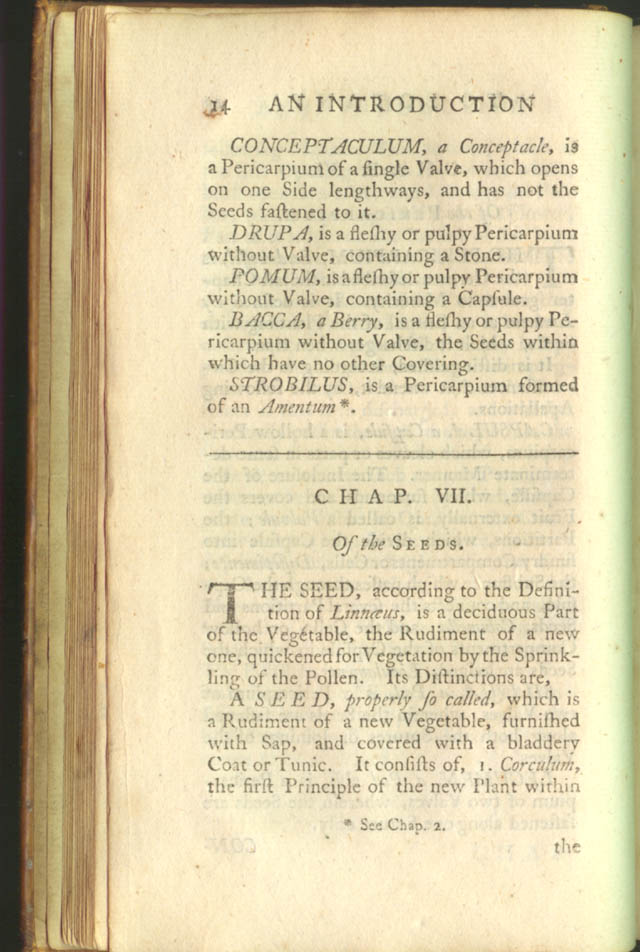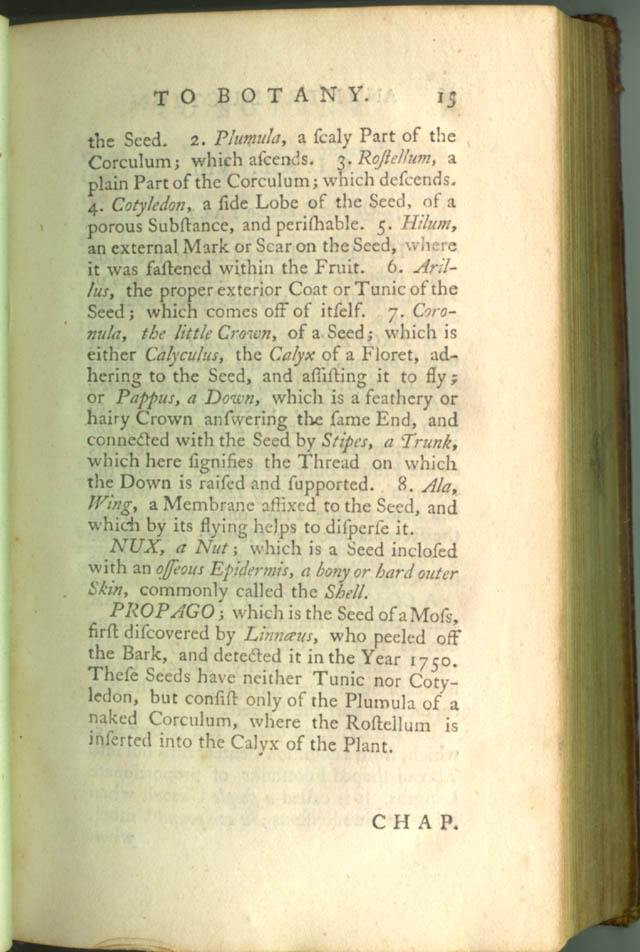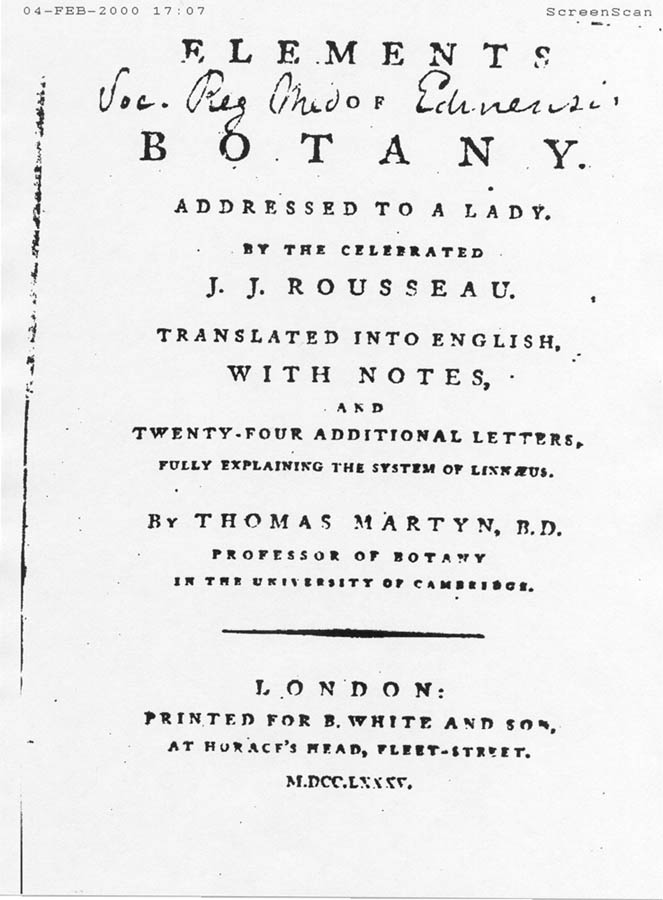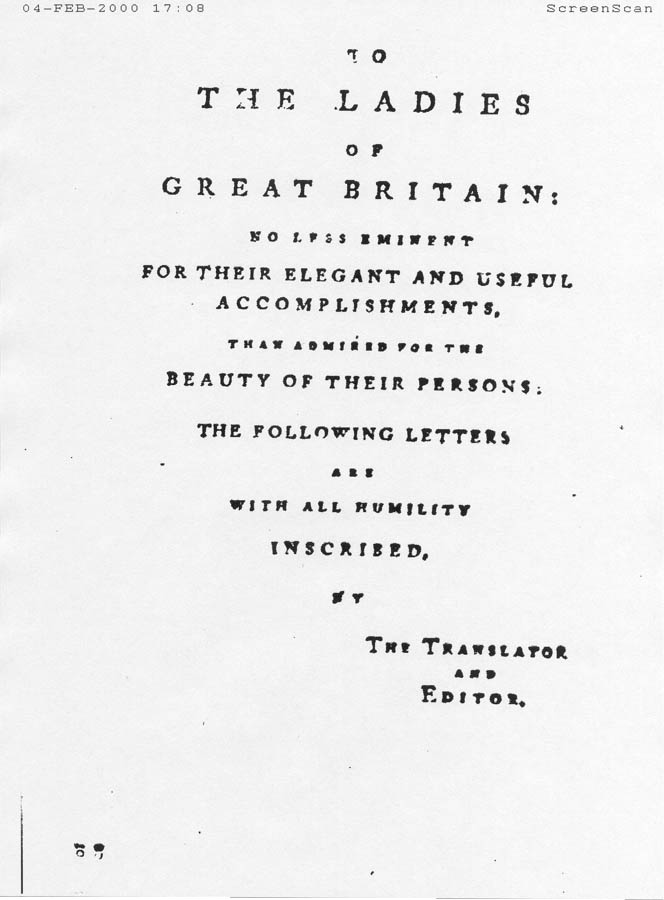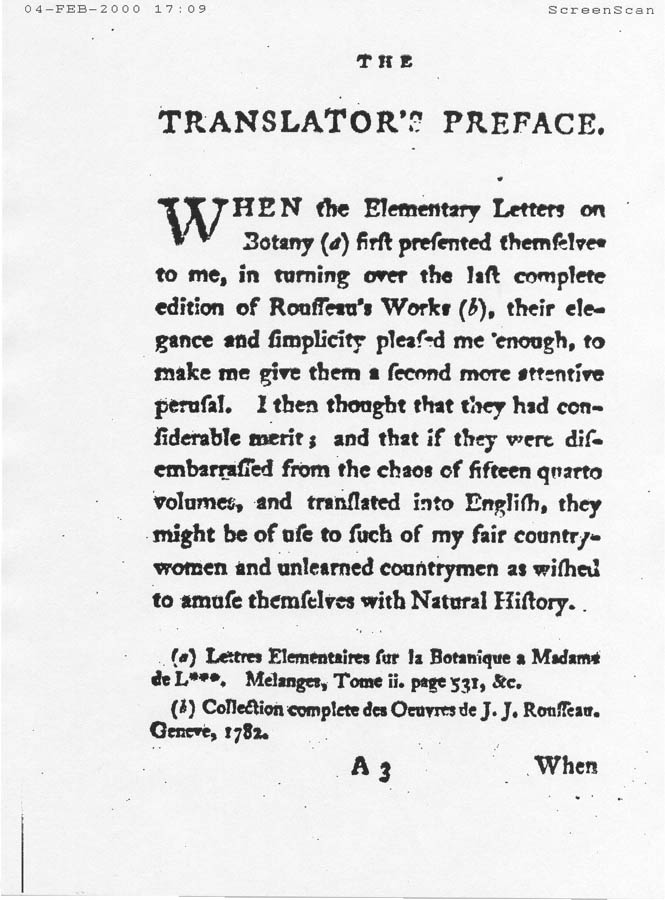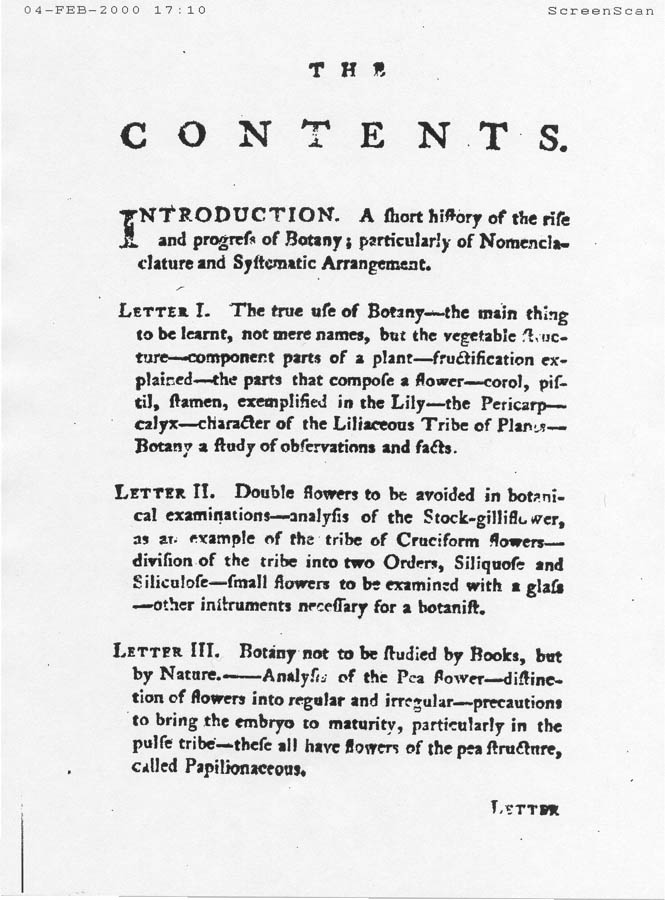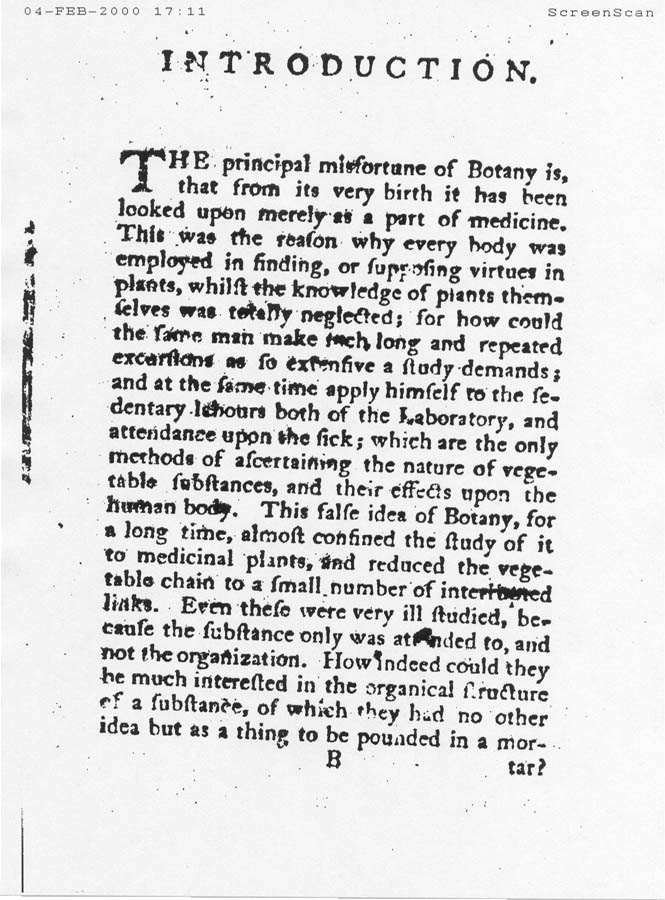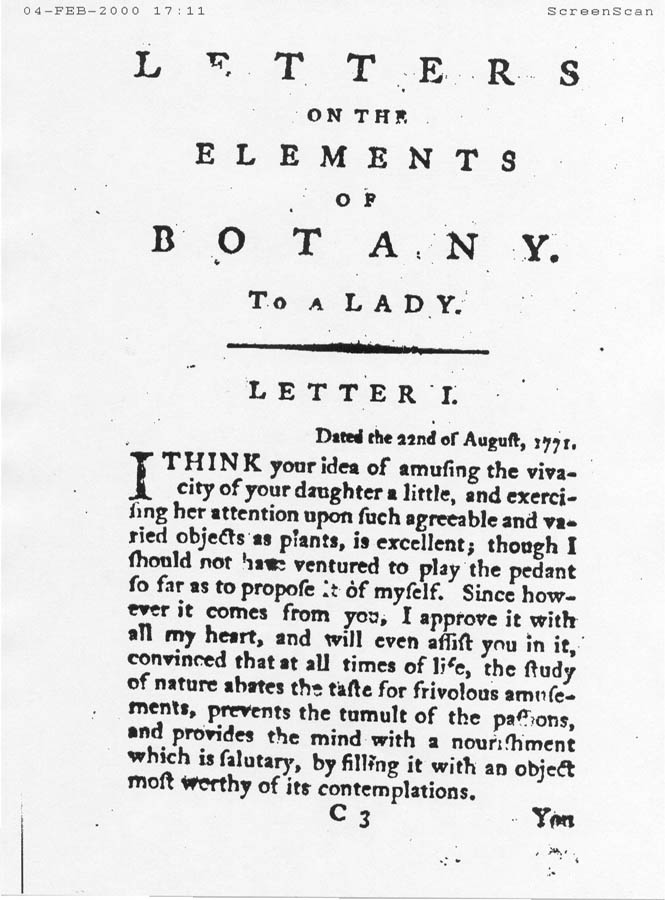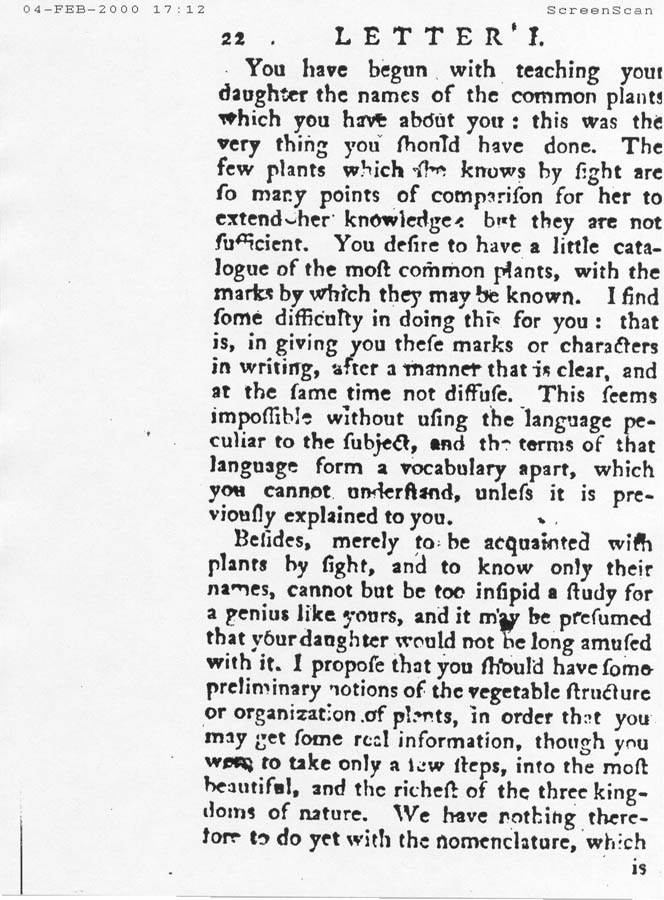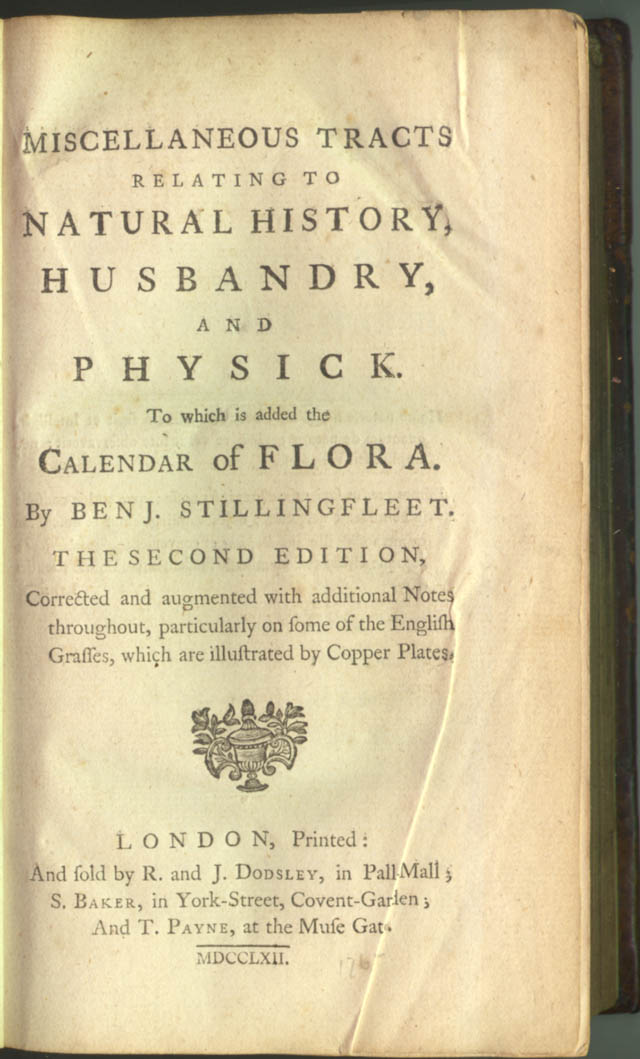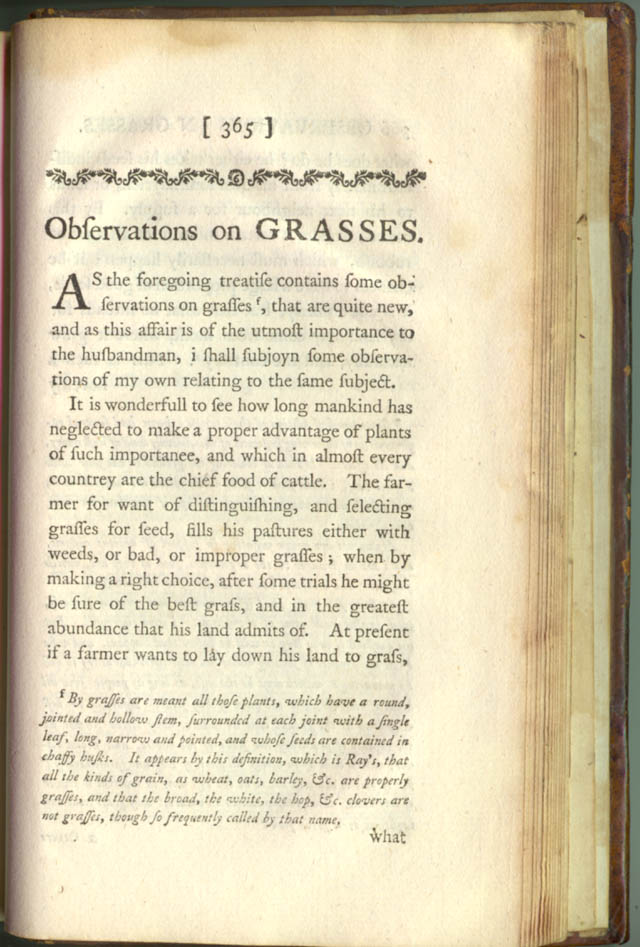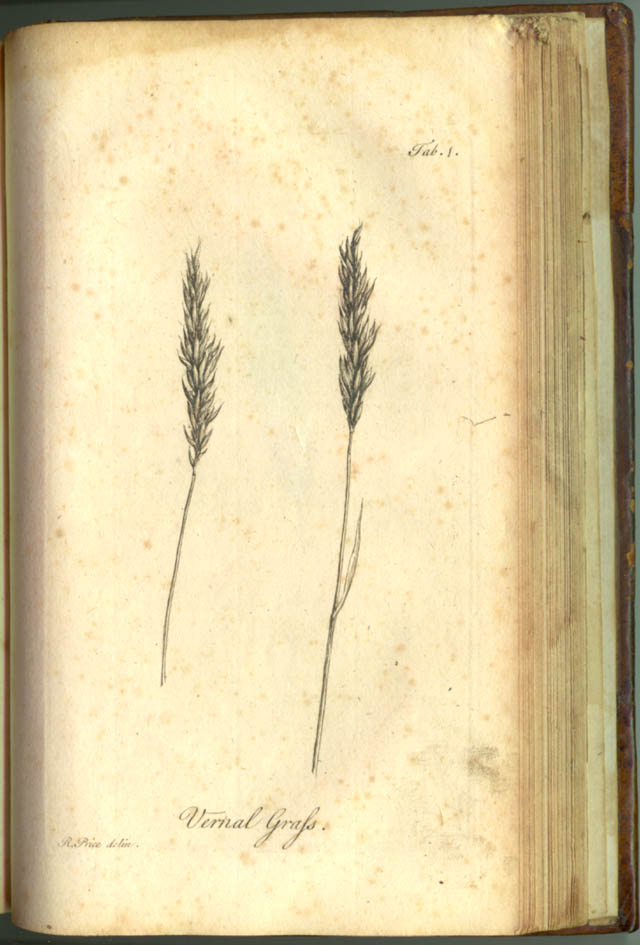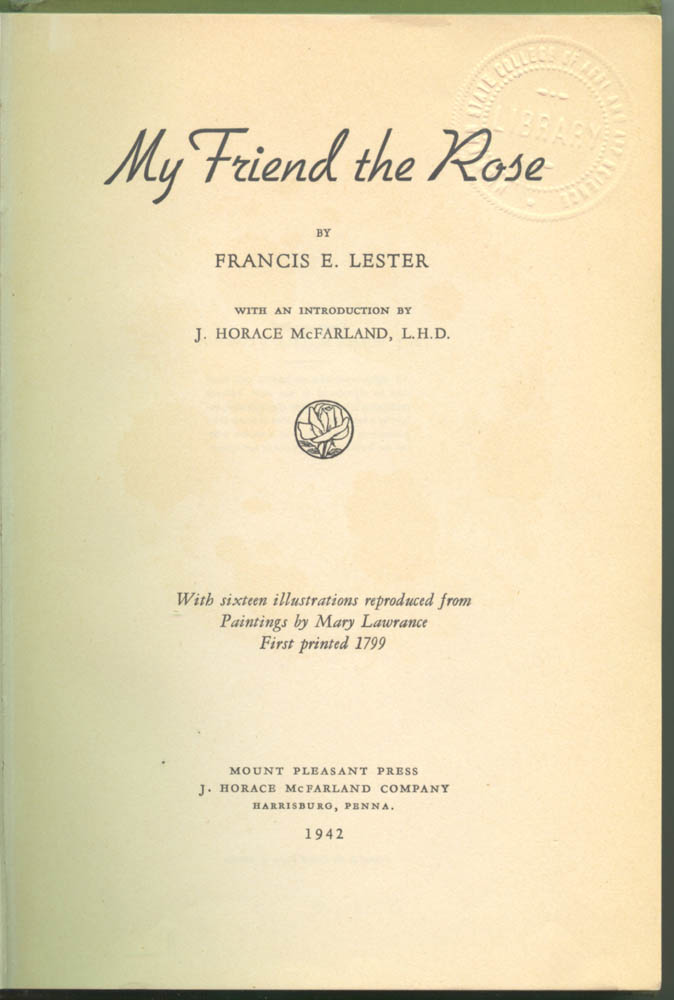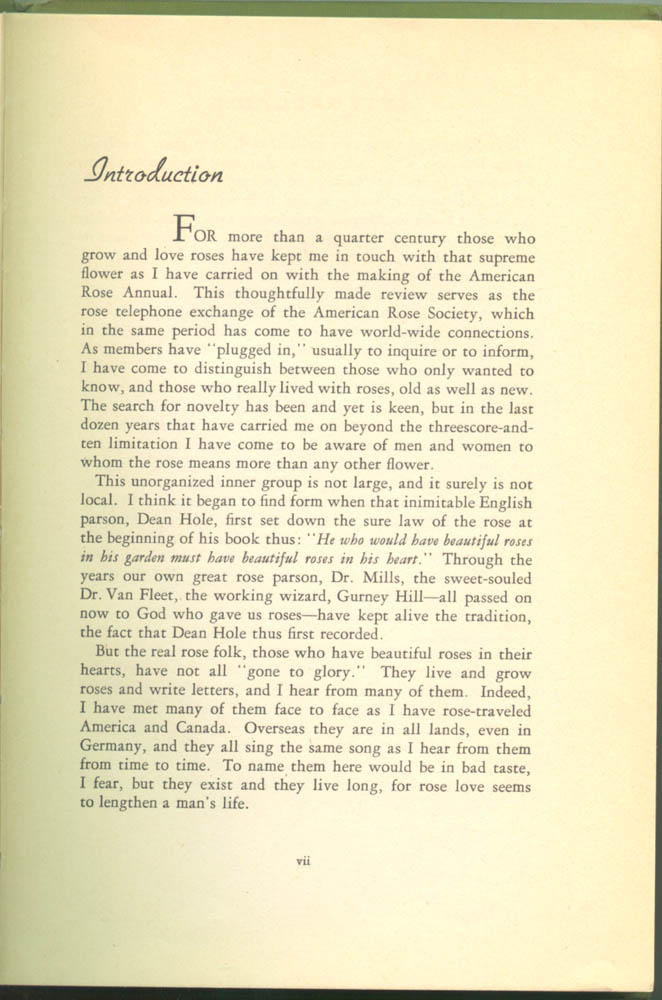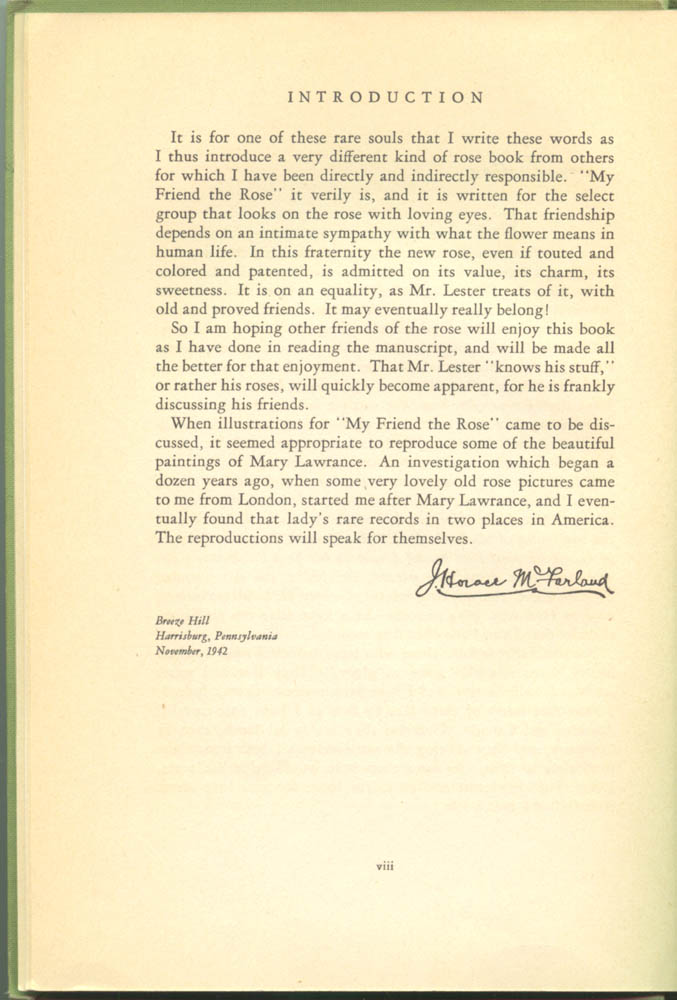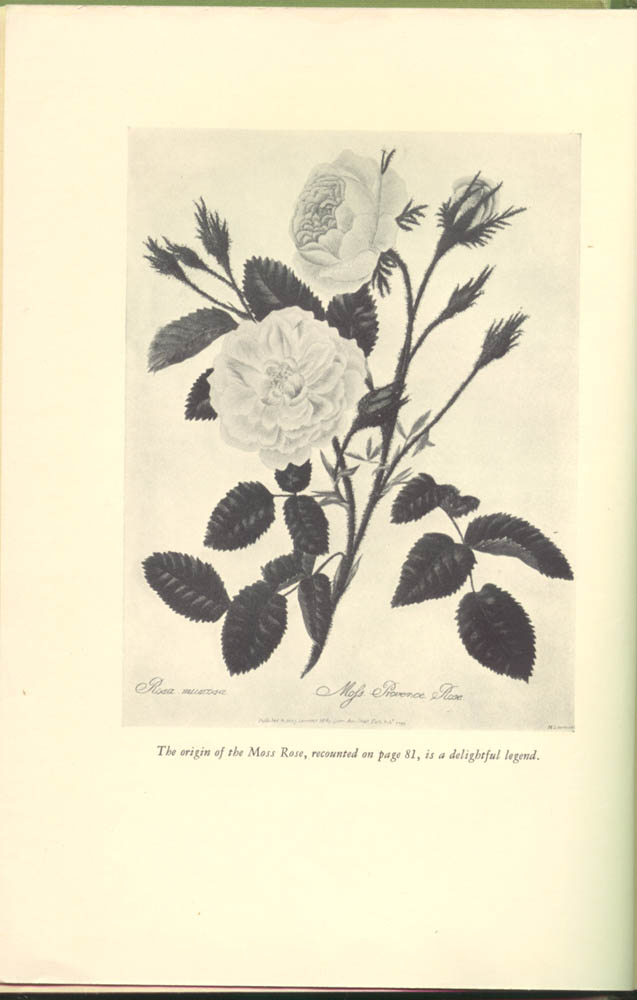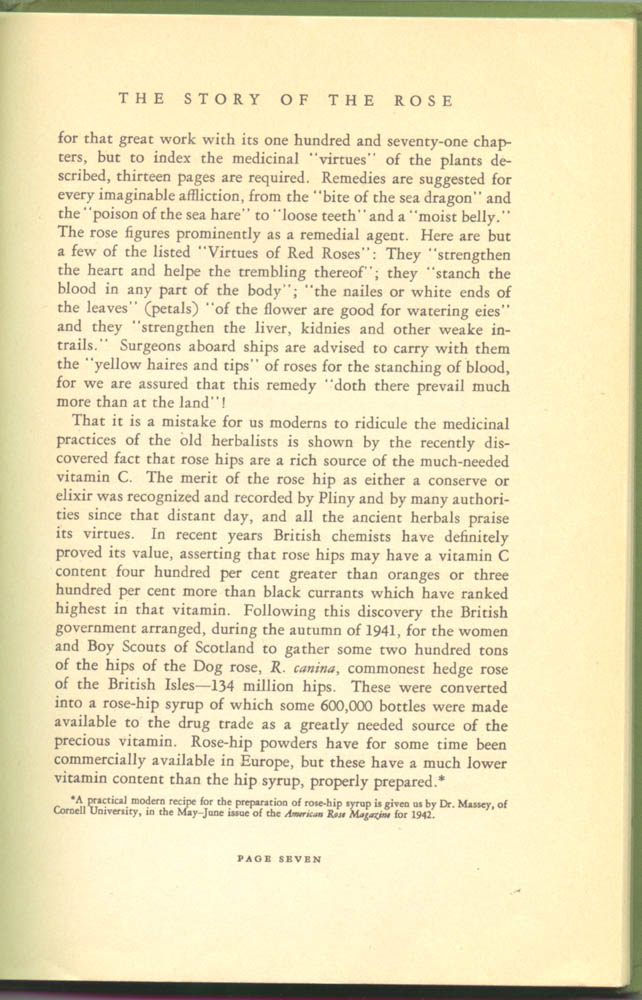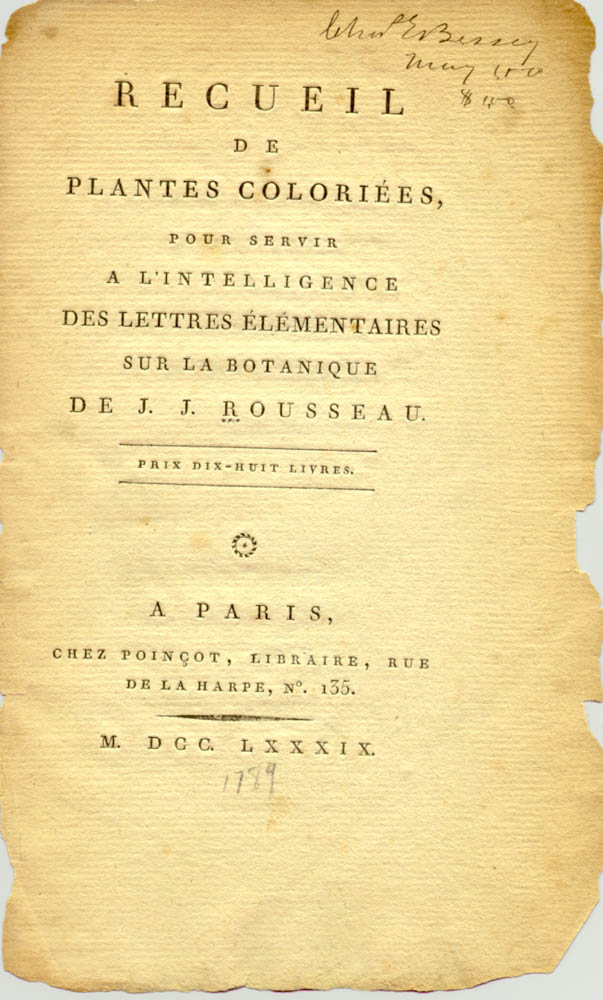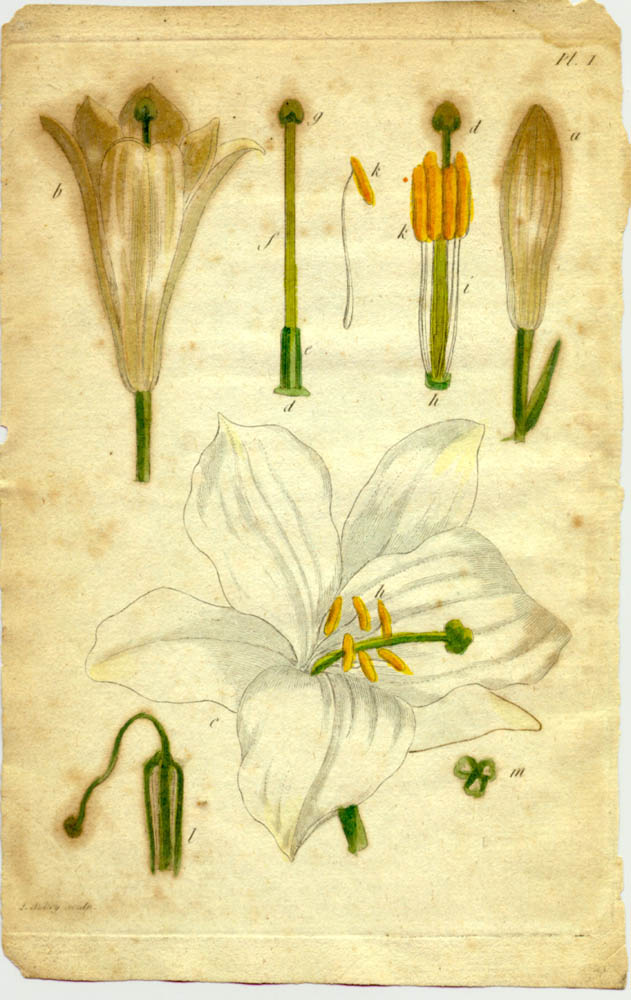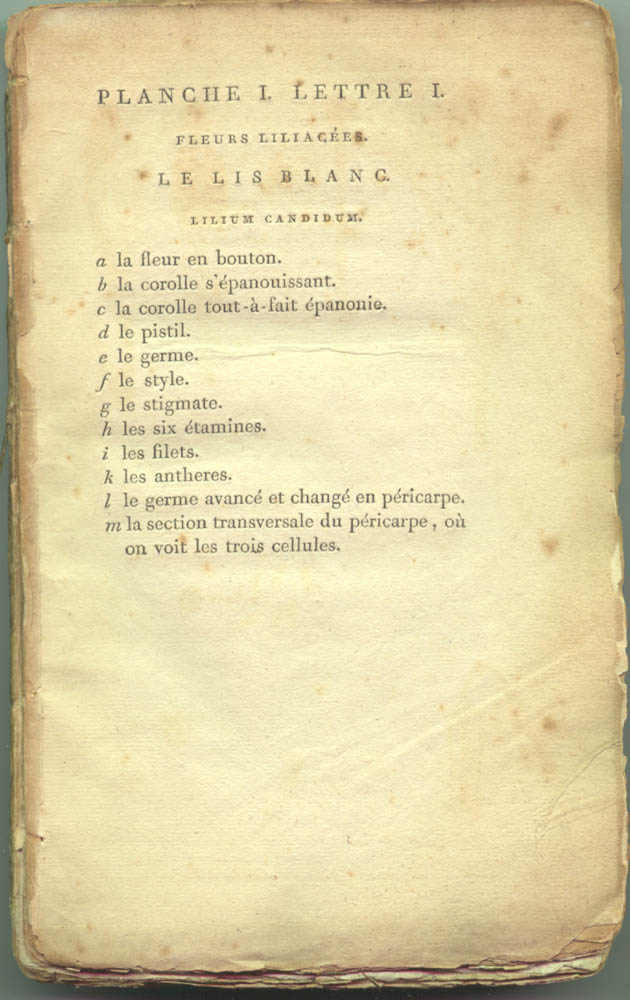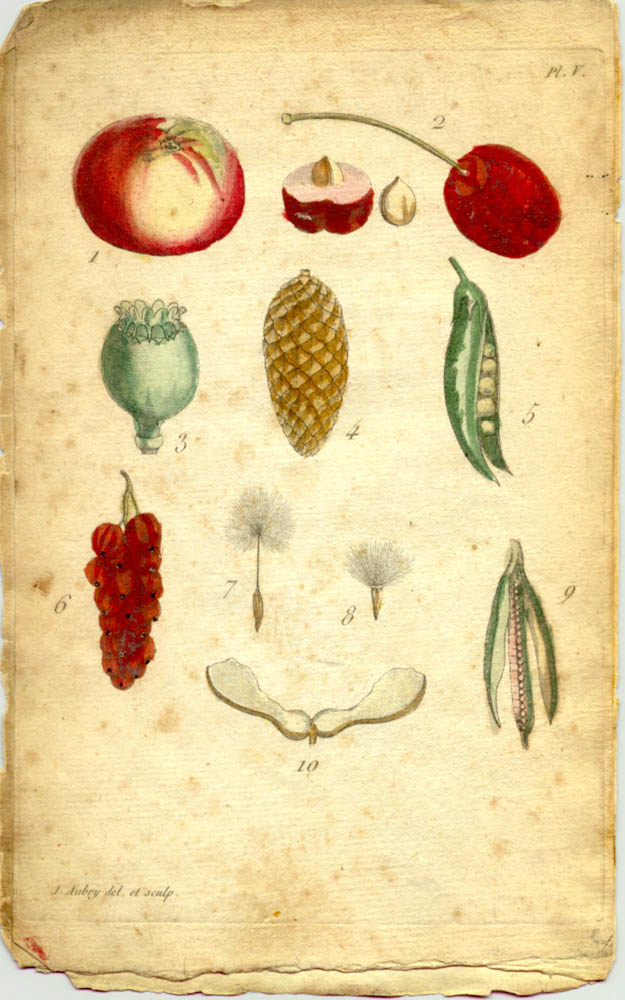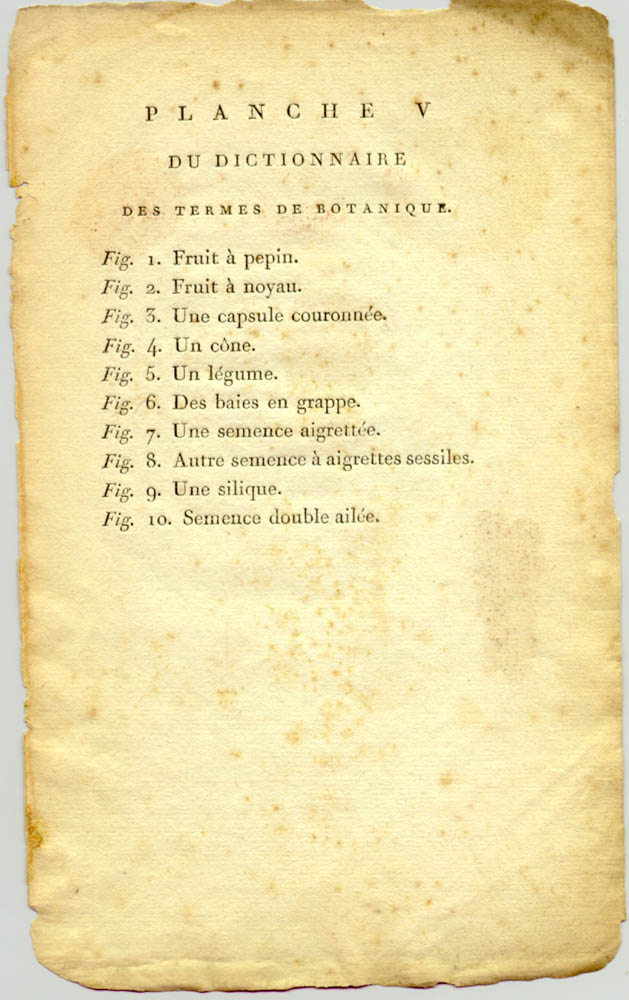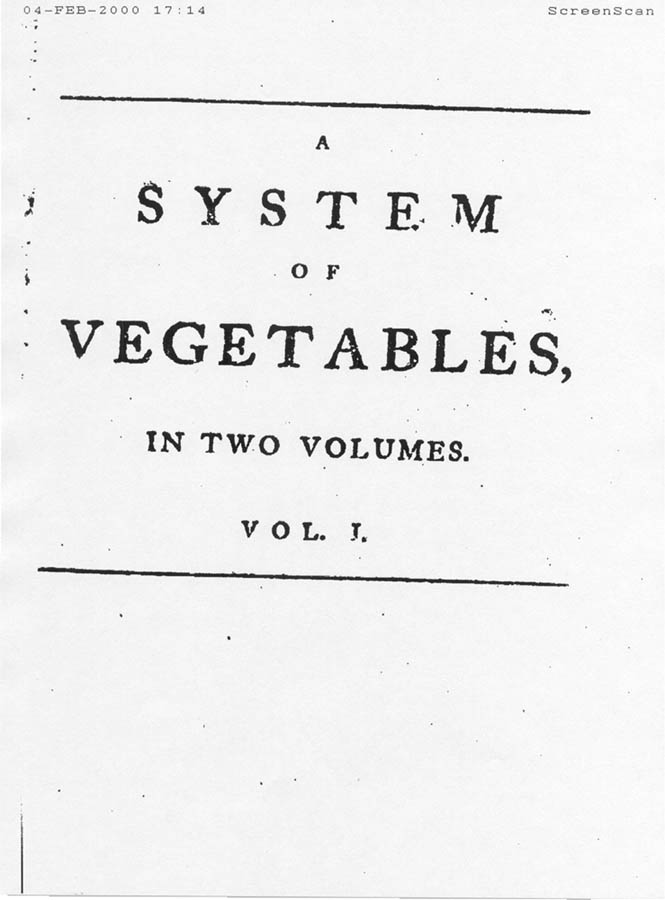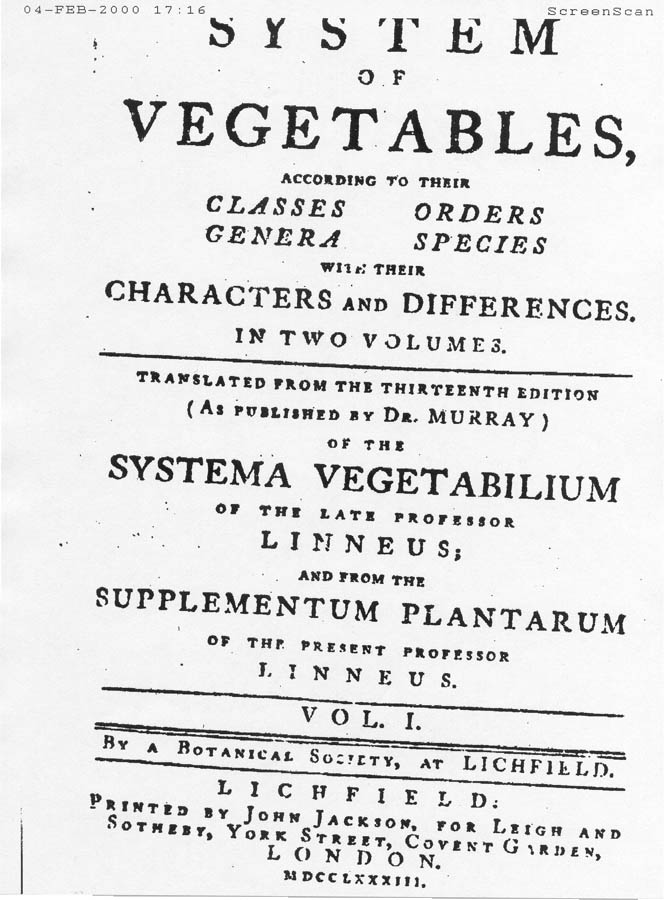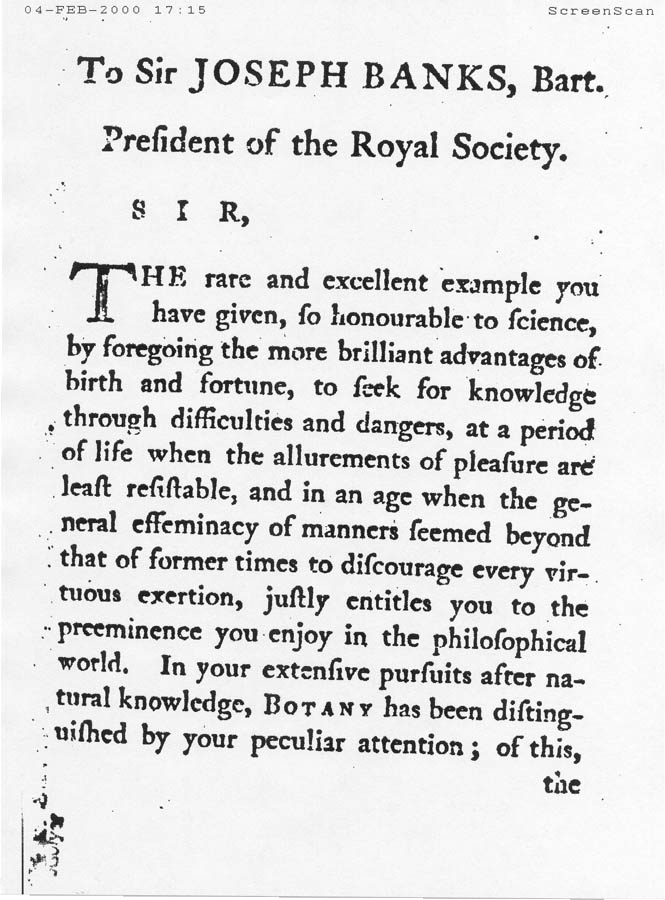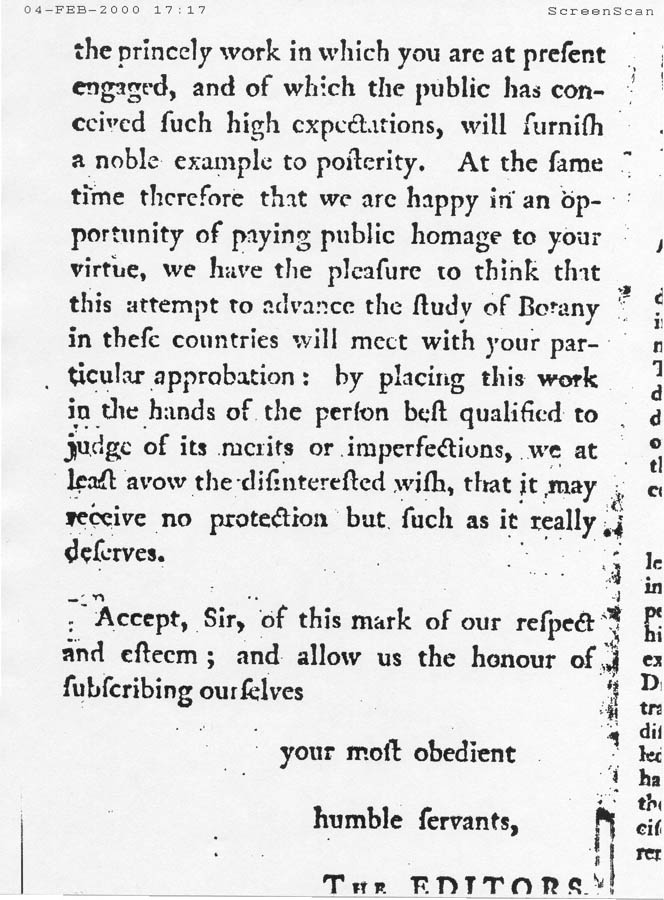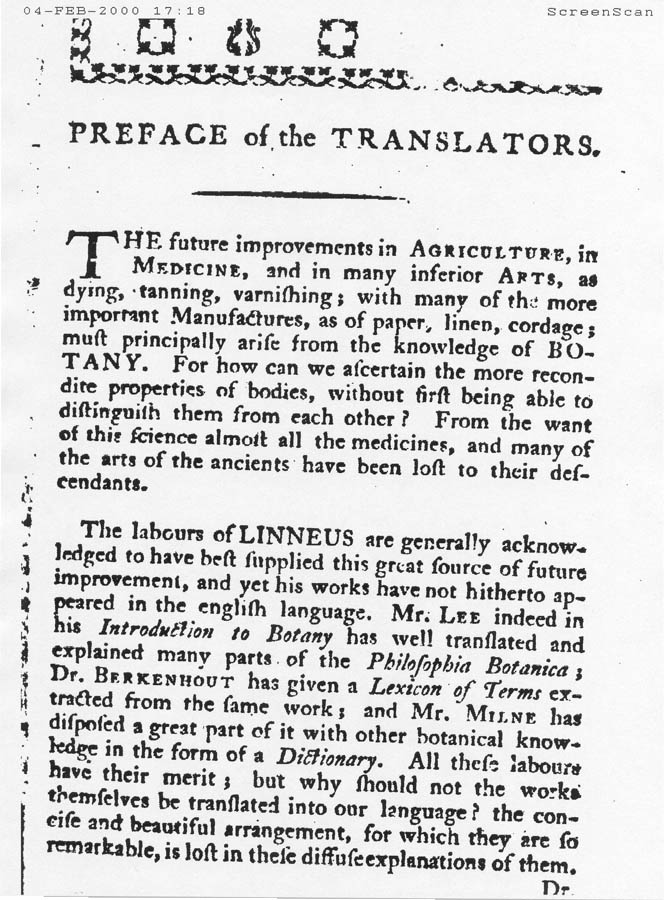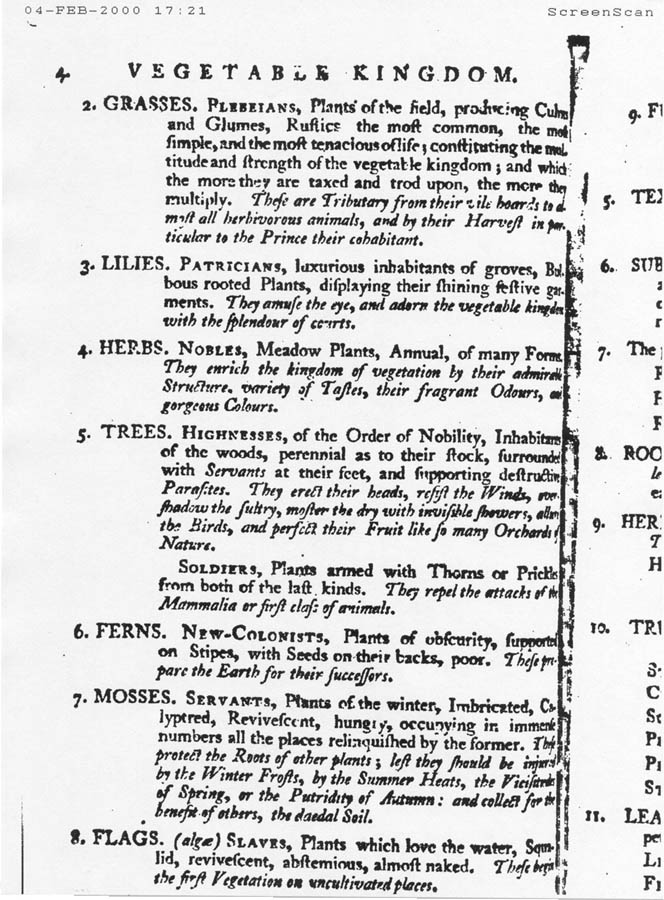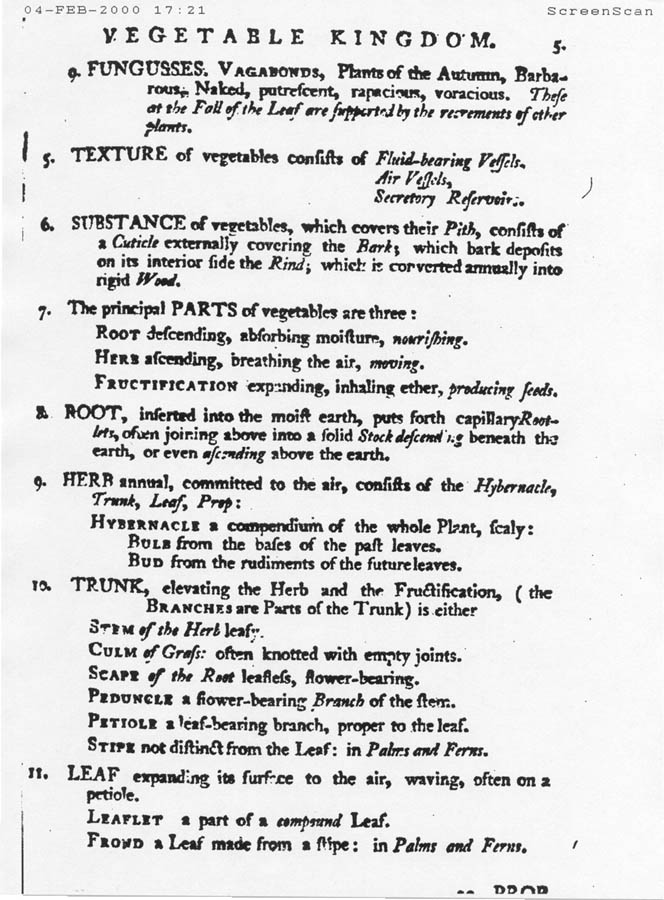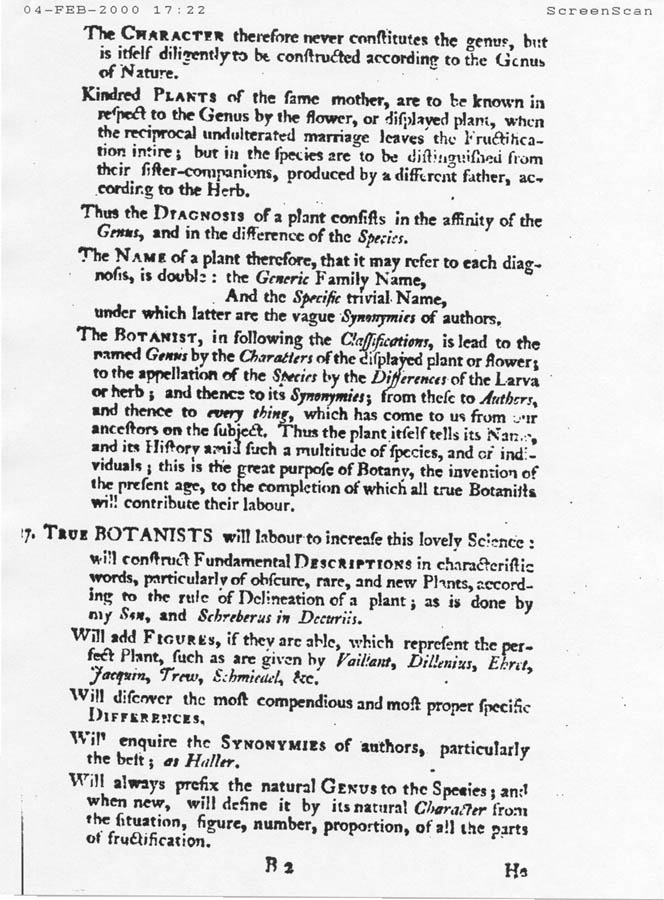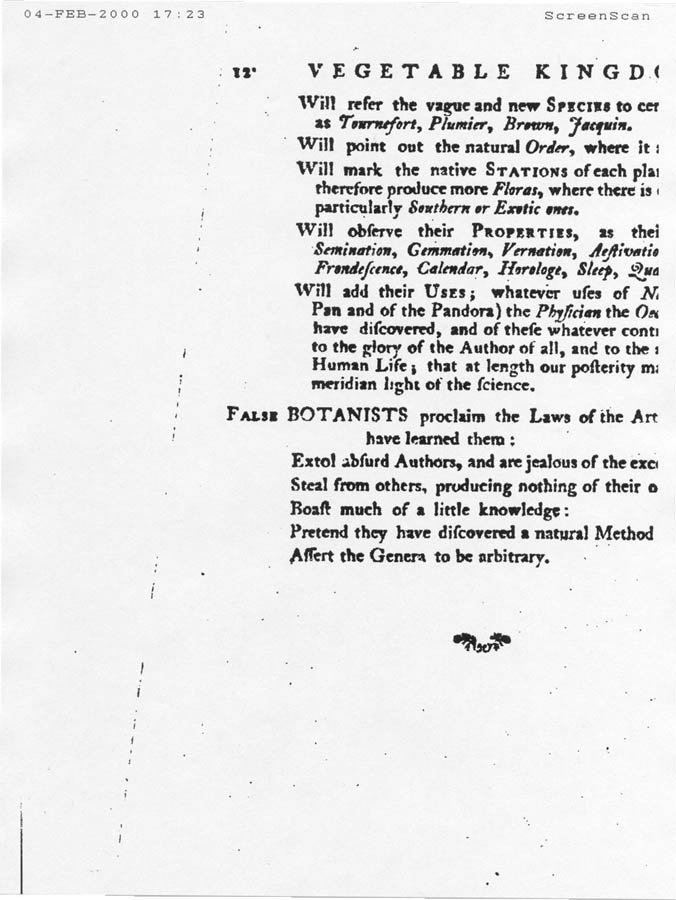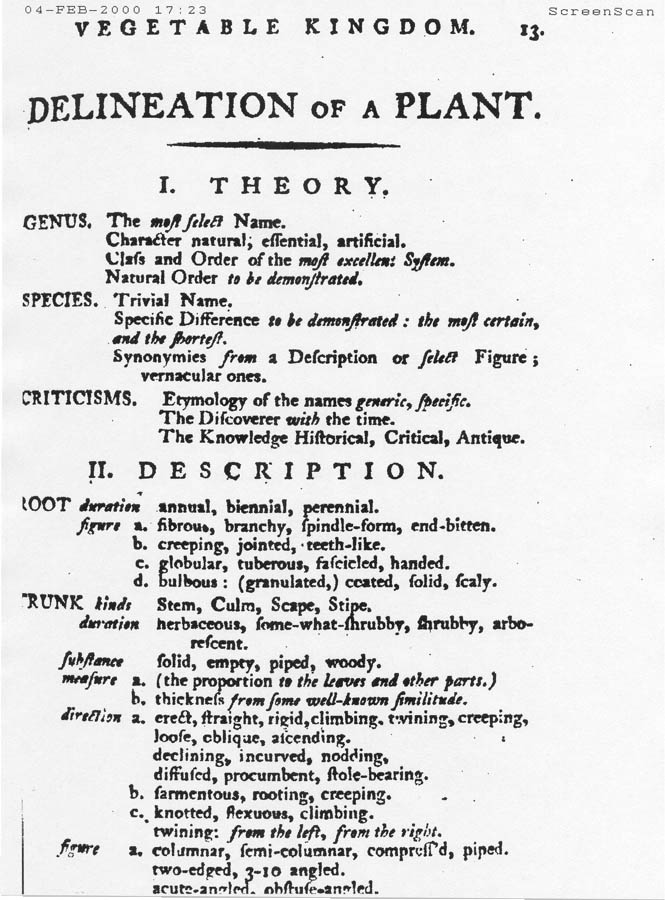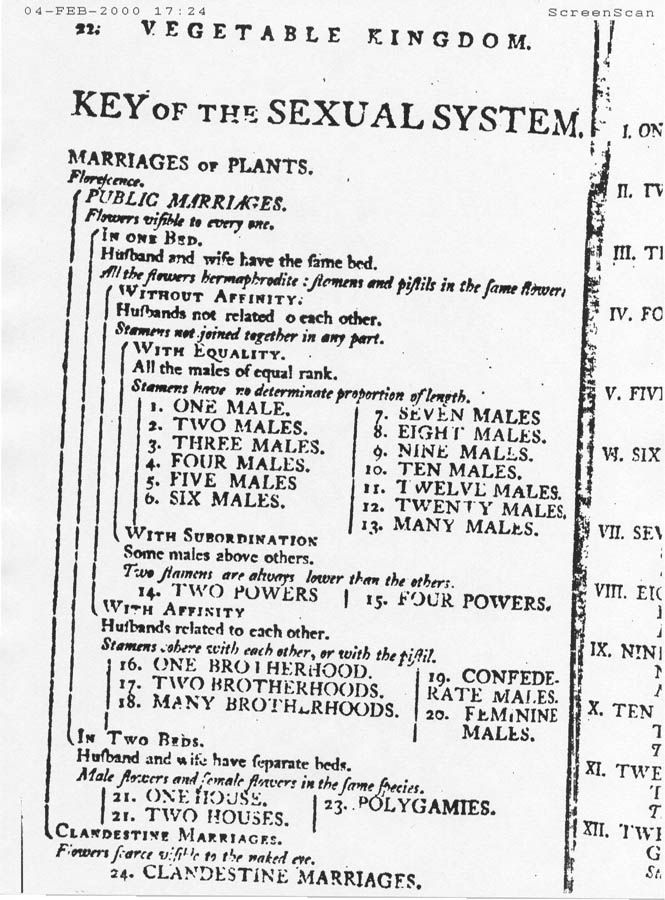
Women and Botany in 18th and Early 19th‑Century England
In the Enlightenment, learning about science became part of general, polite culture. Many authors wrote books for young children, women, or girls to introduce them to the new scientific discoveries about plants. Prior to the 18th century, in England, women’s role with plants had been as providers of home-based health care using herbs to cure diseases, ameliorate physical discomforts, or to make dyes.
Beginning in the 18th century botanical knowledge made a woman a better conversationalist, a better mother-teacher of her children, as well as a better illustrator of beautiful things. Women read and wrote botanical books, went to lectures about botany, corresponded with naturalists, collected and drew plants, developed herbaria, and used microscopes to examine plants. They worked alongside husbands and fathers interested in these pursuits, sometimes even learning Latin. Women frequently wrote about botanical subjects in "informal forms," in poems, introductory books or essays, novels, or books containing letters to, or conversations with, other women or children.
The new ideas to be conveyed included the Linnæan system of plant order and classification, plant physiology and reproduction, as well as facts about newly discovered plants from North and South America, Africa, and Asia. After 1830, as botany became a modern science, a serious occupation for men, women’s status in this field began to decline, along with their cultural contributions.
We hope you will enjoy this exhibit of works from the M.S.U. Libraries’ Collections by women writers and by male writers of works for women, girls, and young children. Most of the books come from our Special Collections. Those represented by photocopies are from The Eighteenth Century or Landmarks of Science microformat sets. Selections are based upon information from Ann Shteir’s Cultivating Women, Cultivating Science, Flora’s Daughters and Botany in England, 1760-1860, Baltimore, Johns Hopkins UP, 1996, Blanche Henrey’s British Botanical Books and Horticultural Literature Before 1800, London, OUP, 1975, and various other reference works.
Agnes Haigh Widder, Humanities Bibliographer
List of Books in the Exhibit
Click on items to view exhibit.
Roberts, Mary
London, J. Hatchard, 1831
Mary Roberts, 1788-1864, produced a stream of books for young readers that combine nature, science, and religion, in order to support herself and her widowed mother. Her works were part of a new stream of writing, separate from the secular Enlightenment culture; she often uses religious imagery to describe plants, rather than employing a systematic and taxonomic approach. In her writing we see how evangelical Christians of the 19th century participated in botanical culture. Like many other writers, she promoted the study of botany as a form of moral improvement. A Quaker and a native of Gloucestershire, she counted among her ancestors the 17th-century Quaker, herbalist, and botanist Thomas Lawson.
Annals of My Village… has a chapter for each month of the year illuminating for rural dwellers the activities in natural world of birds, insects, animals, plants, and farming during that month from her observations. Her goal with this book was to help people who lived in the midst of natural beauty created by God appreciate what they saw and heard more fully.
Her first book was published in 1821, Select Female Biography, Comprising Memoirs of Eminent British Ladies; it features the piety and religious principles and practices of exemplary women from the 17th century on. Another work, published in 1845, was Flowers of the Matin or Even Song, or Thoughts for Those Who Rise Early; it gives a theme for meditation at times appointed for reading lessons from the Book of Common Prayer. Mary was the author of five other books on conchology (shells), the seaside and marine natural history, animal and vegetable production of America, and trees, mosses, and lichens.
Click on thumbnail image to view larger image.
Ibbetson, Agnes.
Agnes Thomson Ibbetson, 1757-1823, daughter of a London merchant, probably came to her interest in botany through the popular and recreational pursuit of it as a polite science. She had no children and her husband, a barrister, passed away in 1790 following a long illness leaving her a comfortable annuity. She went to live near Exeter in Devonshire with her sister, pursuing her reading, philanthropic work, interests in mineralogy and electricity, and in growing, collecting, drawing, and dissecting grasses. Early in the 19th century, she moved into study of plant physiology. When she was in her 50s, she began submitting her work in applied agricultural research, experiments on soil, compost, fermentation, seed formation, plant nutrition, and root structure to general science magazines. She published more than 50 essays like the one shown here, which bridge observational and experimental methods; some were translated and published in Europe. Likely self-taught, she worked without mentors, limited in her contact with other botanists to those who were members of the Bath and West England Society and to those with whom she corresponded. At the time of her death in 1823 her "Botanical Treatise," a 200 page work containing her research over the years, written in the form of letters, was unpublished. In 1810 a plant, the spotted flower Ibbetsonia, ibbetsonia genistoides was named for her. Agnes was a serious, committed botanist, neither deferential nor apologetic in setting out her ideas.
Click on thumbnail image to view larger image.
Ibbetson, Agnes.
The Journal of Natural Philosophy, Chemistry, and the Arts, published by William Nicholson, is but one journal in which Agnes Ibbetson published her work. Marked here are entries in other volumes of the journal owned by the M.S.U. Libraries, in addition to the one opened for display, which contain articles and illustrations by her. These volumes were published from 1809 through 1813.
Click on thumbnail image to view larger image.
Darwin, Erasmus.
London, Printed for J. Johnson, 1791
Erasmus Darwin, 1731-1802, grandfather of Charles Darwin, was a physician, scientist and poet who resided at Lichfield, then at Derby. He was one of the group who first translated Linnæus’ work into English, The Botanic Garden, and a book called Phytologia, or the Philosophy of Agriculture and Gardening…, 1800, containing information on the draining of wet lands and construction of ploughs.
Originally published anonymously, The Botanic Garden is a poem about nature in which the voice of the “botanic muse” tours plant species describing the sexual system of over 80 plants, giving examples of Linnæan classes and orders. It was published in two parts. The second part was originally published in 1789 as “Loves of the Plants.” The first part “The Economy of Vegetation” originally appeared in 1791. Darwin plagiarized some poetry of Anna Seward in the first part, believing he was paying her a compliment; apparently they remained friends anyway. He made quite a lot of money on this work; it was reprinted many times. It is a significant work because “elaborate poetic diction is most incongruously applied to crude facts of science” and because it contains some plates from drawings of Henry Fuseli and some engravings by William Blake.
Click on thumbnail image to view larger image.
Colden, Jane.
Edited by H.W. Rickett and Elizabeth C. Hall. NY?, Garden Club of Orange and Dutchess Counties, NY, [1963.]
This is a reprint of Jane Colden Farquhar’s Botanic Manuscript, the original of which is held by the British Library; it is one of the earliest American local floras, describing, locating, and identifying the plants near her home in the Hudson River Valley. It covers 400 species of plants. She made leaf prints and drawings. She and her father, Cadwallader Colden, the first surveyor general of New York State and also a botanist, sent her work to Linnæus. Jane lived 1724-66, dying in childbirth. She also corresponded with John Bartram, a noted plantsman in America; she was one of the first women to study the Linnæan system. Our copy is a 1963 reprint.
Click on thumbnail image to view larger image.
Withering, William.
Birmingham, Printed by M. Swinney, for T Cadel and P. Elmsley… and G. Robinson… London, 1776.
William Withering, 1741-99, was chief physician at the Birmingham General Hospital and author of this book, an outstanding work of its period on plants growing in Britain. Our copy is a first edition. Withering was also author of a 1785 book on the medicinal uses of foxglove (digitalis), and Botanical Sketches of the Twenty-four Classes in the Linnæan System, with Fifty Specimens of English Plants,…, 1801.
Botanical Arrangement…, a handbook of plant classification written with women readers in mind, introduces the Linnæan system; it was very popular and had many editions. It is a book that Dorothy and William Wordsworth acquired in 1801. Dr. Withering belonged to the Lunar Society of Birmingham, a group of gentlemen who met from 1775-the 1890s to discuss projects at the nexus of science and technology; other notable members were Erasmus Darwin, Josiah Wedgwood, and Matthew Boulton.
Click on thumbnail image to view larger image.
Designed for the Use of Schools, by a Lady. London, Printed for J. Johnson, 1797.
The author, a Lady, is Maria Elizabeth Jackson, often spelled Jacson, 1755-1829. She published all of her works anonymously. She is also the author of Botanical Lectures, 1804, Sketches of Physiology of Vegetable Life, 1811, and Florist’s Manual, or Hints for the Construction of a Gay Flower-Garden, with Directions for Preventing the Depredations of Insects, 1816 and 1822. Mary Elizabeth was a provincial gentlewoman who lived with her brother in Derbyshire after her father died. Records about her and her works are scanty; there are no letters, diaries, or manuscripts known to exist. It seems that she may have met Erasmus Darwin through her cousin Brooke Boothby; this connection enabled her to live on the fringes of the literary and scientific cultural life of which they were central figures. She wrote and published in mid-life to support herself. It is possible that Botanical Dialogueswas written for the Parker sisters, Darwin’s daughters, who kept a school. J. Johnson was Erasmus Darwin’s and Mary Wollstonecraft’s publisher, too.
Botanical Dialogues teaches the rudiments of Linnæan botany. It is a long, relentlessly earnest, compendious, densely packed book about Linnæan nomenclature and taxonomy. It contains reproductions of the parts of plants, discusses modes of flowering, classes, genera and orders, so that students can identify plants, and covers plant reproduction. The author did not believe in oversimplifying the Linnæan system to popularize it; she is clearly more botanist than educator. The form employed is conversational. Hortensia is both mother and teacher. Children should study plants with her as an amusement, after the formal lessons for the day end..
Click on thumbnail image to view larger image.
[s.l., s.n.], 1878-1800. (London, Printed for W. Curtis by S. Couchman).
William Curtis, 1746-1799, founded this monthly periodical, one of the oldest such periodicals of its kind, and is still being published, in response to the English people's demand for such reading. The first four volumes contain hand-colored plates by James Sowerby, a noted plant illustrator. In the 1770s Curtis organized field trips in and around London for gentlemen "Who wish to acquire a knowledge of plants growing wild about town, or of Linnæus’ system of botany." Curtis was demonstrator at the Chelsea Physic Garden, the facility of the Worshipful Company of Apothecaries, where his work was to teach apprentice apothecaries to recognize medicinal plants in the wild. He had his own garden at Lambeth and was partner in a nursery located first at Brompton and then in Chelsea. He is the author of several works on botany.
Click on thumbnail image to view larger image.
Murray, Charlotte.
London, Thomas Wilson, 1808
Originally published in 1799 in two volumes this work is organized according to the Linnæan class and order system. The introduction explains "how to discover the name of any unknown plant." The book is a combination of descriptive catalog and Linnæan botanical instruction. Its goals are to cultivate an interest in botany and to promote it as a more accessible study than other sciences. The audience is young people and other beginners; its reviewers found it "useful, convenient, and well-compiled, suited to young botanists and dilettanti when visiting botanical gardens." It was an expensive work (16 shillings), yet it sold well and was reprinted over the next decade. Obviously, it was for wealthy consumers to activate a love of looking at plants. Lady Charlotte Murray lived 1754-1808; she was a daughter of John, Third Duke of Atholl, a man interested in reforestation on his estates in Scotland. Her work is typical of women’s botanical writing of the period; the author sees herself modestly, writes for young people and other amateurs, incorporates Linnæan views, and wants to encourage people to love and know plants.
Click on thumbnail image to view larger image.
Marcet, Jane Haldimand.
Charleston, S.C., J. Grigg and W.P. Bason, 1824
Originally published in 1819, this is a copy of the second edition. Conversations on Natural Philosophy… was an explanation of the first elements of science for very young children, presented in the familiar style. Jane’s first published book was Conversations on Chemistry, 1806. She was a very prolific author of popular science texts for children, women, and general audiences. In 1829 she published Conversations on Vegetable Physiology, which teaches the structure of plant roots, stems, seeds, plant functions, such as nutrition and transpiration, and applied subjects such as techniques of transplanting and grafting, and about plant diseases. It was a more learned work than many others by women at the time. It received good reviews in the Magazine of Natural History. Jane was the only daughter of a Swiss merchant established in London. She married a physician, Alexander Marcet, in 1799, by whom she had three children. He was a lecturer in chemistry at Guy’s Hospital in London. Through him she had access to contemporary scientific research. She was acquainted with other noted women writers, such as Mary Somerville, Maria Edgeworth, and Harriet Martineau. She wrote anonymously, not thinking of herself as "scientific;" she thought of herself as a popularizer and a teacher, just wanting to be useful. She wrote 19 books altogether.
Click on thumbnail image to view larger image.
Abbot, Charles.
Bedford, Printed and Sold by W. Smith, 1798
Rev. Charles Abbot, c1761-1817, was a grammar school teacher who became an ordained minister in Bedfordshire. He was elected a fellow of the Linnæan Society in 1793 and submitted his ’Plantae bedfordiensis,’ a list of 200 less common plants of the county of Bedforshire to the Society in 1795. The work was published in 1798 and is considered a model of a county flora. It lists 1,325 flowering plants. He describes each species and the general place of its growth. The author claims in the dedication and preface that he designed the book for the amusement and instruction "of the fair daughters of Albion." He dedicated the book to Queen Charlotte; she and her two daughters were "into botany," as we would say it today. Queen Charlotte did much to make the pursuit of the subject a fashionable one among nobility and gentry women of her time. Charles’ wife, Sarah, assisted him in his work by developing his herbarium. The specimens of plants she prepared were also useful to James Edward Smith in his works English Botany and Flora Britannica.
Click on thumbnail image to view larger image.
Bryant, Charles.
London, B. White, 1783.
This is the second of three books by Charles Bryant, d. 1799, Beadle of the Court of Guardians for the City of Norwich. One of his peer referred to him as "in most instances, an accurate observer and investigator of botanical subjects." This work adds to the material collected by Hugh Rose, (1717?-92), apothecary of Norwich, author of Elements of Botany, who was collecting the Linnæan names of esculent plants.
Click on thumbnail image to view larger image.
Lee, James.
London, Printed for J. And R. Tonson, 1765.
Originally published in 1760, James Lee’s (1715-1795) Introduction to Botany translated Carl Von Linne’s (Linnæus’) ideas on the order and naming of plants based upon examination of their sexual organs and reproductive methods into English. Linnæus’ ideas spread widely in England in the 1760’s. Lee was gardener at Syon House, a partner in a nursery in Hammersmith, had plant collectors in American and in South Africa, and corresponded with Linnæus. He is the author of this and Rules for Collecting and Preserving Seeds from Botany Bay, c 1787; he contributed to the Hortus Kewensis, v. 1, 1789, a catalog of plants at Kew Gardens.
Click on thumbnail image to view larger image.
Wakefield, Priscilla.
London, Printed by and for Darton and Harvey, 1807
Known in its time as "Wakefield’s Botany" this is a fifth edition; the work was first published in 1796. It was a popular work, going into 11 editions over 40 years. It was also translated into French and published in America. It is a text for children, designed to "cultivate a taste in young persons for the study of nature" by familiarizing the system of Linnæus in the form of letters from a young lady to her sister, with illustrations. The narrator, a governess, gives botanical lectures, which the young woman writes to her sister about. They give an overview of the Linnæan system; the plates illustrate parts of plants, including the reproductive system, which was controversial. Plant sexuality is side-stepped; this was also a controversial topic. Living from 1751-1832, the author, a nominal Quaker, was known for her children’s books on science and travel and for her philanthropic work setting up savings banks. She thought learning about plants was a much better use of young girls’ time than any number of other fashionable pursuits. Between 1794 and 1816 she wrote 16 natural history books and travelogues for young people, as well as the significant Reflections on the Present Condition of the Female Sex.
Click on thumbnail image to view larger image.
Rousseau, Jean-Jacques.
Translated into English, with Notes, and Twenty-four Additional Letters, Fully Explaining the System of Linnæus, by Thomas Martyn. London, Printed for B. White, 1785
Rousseau published his Lettres Elementaires Sur La Botanique in 1771-73. This work contains eight letters teaching a young mother about botany and how to study it so she can teach the subject to her daughter. Rousseau addressed the work to Madame Delessert, the mother of the French financier Benjamin Delessert, 1773-1847, who was a keen botanist and the owner of a famous herbarium and botanical library. Botany was a favorite amusement of Rousseau’s in later life. Thomas Martyn, a professor of botany at Cambridge and one of the earliest exponents of Linnæan classification, translated Rousseau’s work into English in 1785. He added 24 letters of his own on the subject in the edition shown here. Over the next 30 years there were eight editions of Martyn’s work; it was a very influential, popular work on botany. A lady should be able to identify plants herself!
Click on thumbnail image to view larger image.
Selected and Translated by Benjamin Stillingfleet. London, R. And J. Dodsley, 1762.
First published in 1759; this is the second edition. Contains English translations of several academical dissertations done under Linnæus’ supervision, a piece by Linnæus, and an essay by Stillingfleet on grasses. Stillingfleet, 1702-1771, an author, naturalist and scholar, took up gardening to rest his inflamed eyes. This led him to study herbals, botany and similar subjects. He was probably introduced to the Linnæan system between 1750 and 1755.
Click on thumbnail image to view larger image.
Lester, Francis Edward.
With Sixteen Illustrations Reproduced from Paintings by Mary Lawrance, First Printed 1799. Harrisburg, Pa., J. Horace McFarland Company, 1942
We chose this book for the display because of its illustrations by Mary Lawrance Kearse, who flourished from the 1790s-1830. Mary was an artist, teacher of botanical drawing, and exhibitor at the Royal Academy from 1794-1830. Her books include A Collection of Passion Flowers Coloured from Nature, [1799]-1802, A Collection of Roses from Nature, [1796]-1799 (from which the illustrations in this book by Lester are taken), and Sketches of Flowers from Nature, 1801. A Collection of Roses contains an ornamental frontispiece and 90 plates of flowers; Sketches of Flowers from Nature is a manual on botanical drawing for students. Mary drew, etched, and coloured all her own illustrations. Although her drawings have their limitations, her plates are effective and well-representative of the plants depicted. She dedicated A Collection of Roses to Queen Charlotte; as a result, "the demand for this book on roses was far in excess of the number of copies printed." Mary Lawrance was a very popular teacher and continued teaching and exhibiting her work even after her marriage. "All that was interesting and beautiful in the Vine nursery, Hammersmith, soon made its way to her house in Queen Anne street. Not only Mr. Lee, but most of the other nurserymen, made a point of sending her their new flowers to be drawn by her. It was thought to be an honour for the owner as well as the flower when Miss Lawrance painted its portrait."
Click on thumbnail image to view larger image.
Smith, Charlotte Turner.
Edited by Stuart Curran. NY, Oxford University Press, 1993
Although known primarily for her novels, Charlotte Turner Smith also was a successful poet and natural history writer. Her poems show that she possessed much technical knowledge of botany and have many specifics about plants. It was entirely customary, and very typical, for women writers about the natural world to use the verse form in this period.
Click on thumbnail image to view larger image.
Martyn, Thomas.
Paris, Poinot, 1789
Also shown is a translation of Martyn’s Thirty-eight Plates, with Explanations, Intended to Illustrate Linnæus’ System of Vegetables, and Particularly Adapted to the Letters on the Elements of Botany into the French language. This publication further encouraged botanical study.
Click on thumbnail image to view larger image.
Kent, Elizabeth.
London, Taylor and Hessey, 1825
Elizabeth Kent flourished in the 1820s and 1830s. Her older sister married Leigh Hunt, the romantic essayist, critic and newspaper editor. Her step-father was a publisher. She never married, but because of her family connections she was part of the Hunt social circle in the Hampstead area of London. Various members of the romantic circle including Hunt, Byron, Coleridge, Mary Shelley, and John Clare were enthusiastic about her works, which are transitional between literary accounts about plants and systematic, scientific accounts. Her Flora Domestica, or the Portable Flower Garden, 1823, for which she is best known, and Sylvan Sketches…, 1825, shown here, integrate nature and narrative, science and art, horticulture and romantic languages of nature in ways that signify changing directions in early 19th century plant culture, looking forward to a more scientific approach to the subject. Flora Domestica… describes in a charming and informal style 200 flowers, shrubs, and small trees which could be grown in containers, which was becoming popular with town dwellers. She advises on cultivation, propagation, and watering mixed with anecdotes, poetic associations, folklore, and mythology.
Sylvan Sketches… describes 80 hardy trees and shrubs common in England, providing factual information about the plants along with their cultural associations and usages in other parts of the world, citing explorers and travel writers. She is about evoking feelings, illustrating the spiritual and aesthetic effects of trees by celebrating the poets who wrote about them, pleasing the eye, and enlarging the readers’ sensibilities, all to encourage more people to be interested in science and plants.
As long as reviewers were paid Elizabeth also wrote for the Magazine of Natural History, contributing a series of nine essays on Linnæan botanical classification and identification of plants and their culinary and medicinal uses. She taught botany and wrote a couple of books for children. She wrote a chapter called "The Florist" for The Young Lady’s Book, 1829. In December, 1860, she was living with a nephew in Covent Garden and complaining about the status of women in botanical culture; too many women did not care whether they knew very much about this subject, women were excluded from research oriented botanical gardens, and too many male botanists were unhelpful in opening doors for women to the study of exotics.
Click on thumbnail image to view larger image.
Linn, Carl von.
Translated from the 13th edition (as Published by Dr. Murray) of the Systema Vegetabilium of the late Professor Linneus, and from the Supplementum Plantarum… by a Botanical Society at Lichfield. Lichfield, Printed by J. Jackson for Leigh and Sotheby, 1783
This is the first English language translation of Linnæus’ Systema Vegetabilium, a catalog of over 1400 plants divided into the 24 classes of the Linnæan system. It was made from a condensed edition of the work in Latin published by John Anders Murray, 1740-91. The translating was done by "a Botanical Society at Lichfield," the members of whom seem to have been Erasmus Darwin, Brooke Boothby, and John Jackson. The completed work had four parts bound in two volumes. Supplementum Plantarum was by Linnæus’ son Carl. There were reviews of the work in two issues of the Monthly Review, in volumes 68 and 72, in 1783 and 1785.
The 1785 Monthly Review comments "What a fund of elegant amusement is now laid open! The field and the garden are rendered intelligible! At length the female sex, and the un-latinified, can make their way, and reap those enjoyments, which their forefathers could obtain, but more painfully, from ancient herbals, from their favoured Gerard, and the laborious Parkinson. Worse pursuits will perhaps now be deserted, when such a rational one is within everyone’s reach. Where botanical knowledge becomes general, the knowledge of medicine, of chemistry and of arts, and the love of botanical culture usually increase with it. In all probability botanical gardens will multiply; hence horticulture may fairly be expected to improve. Rare plants will be found in more general hands; and England will confessedly take the lead in this science. Every thing, which from its being curious, or ingenious, or useful, adds to the honour of the State…"
Click on thumbnail image to view larger image.
Smith, Charlotte Turner.
London, Printed for T. Cadell, Jun. and W. Davies, 1798
A novel originally published in 1798 in four volumes in which the hero teaches his sister to be a "rational companion" and to "draw scientifically." The author modestly claims in the preface a "slight knowledge of natural history." Smith’s work shows the dense interweaving of women, gender and botanical culture in England at the turn of the century. She loved botanical pursuits, was talented in drawing as a girl, taking lessons with a landscape painter. She did watercolors of plants and flowers all her life. She integrates botanical expertise into popular novels, such as this one, into juvenile natural histories, such as Rural Walks and into her poetry.
Click on thumbnail image to view larger image.
Citation (Chicago):
Widder, Agnes Haigh. “Women and Botany in 18th and Early 19th-Century England.” Michigan State University Libraries. Accessed [date of usage by patron]. https://lib.msu.edu/exhibits/botany.

